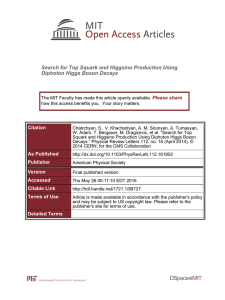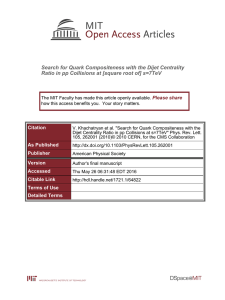Measurement of the t-Channel Single Top Quark
advertisement
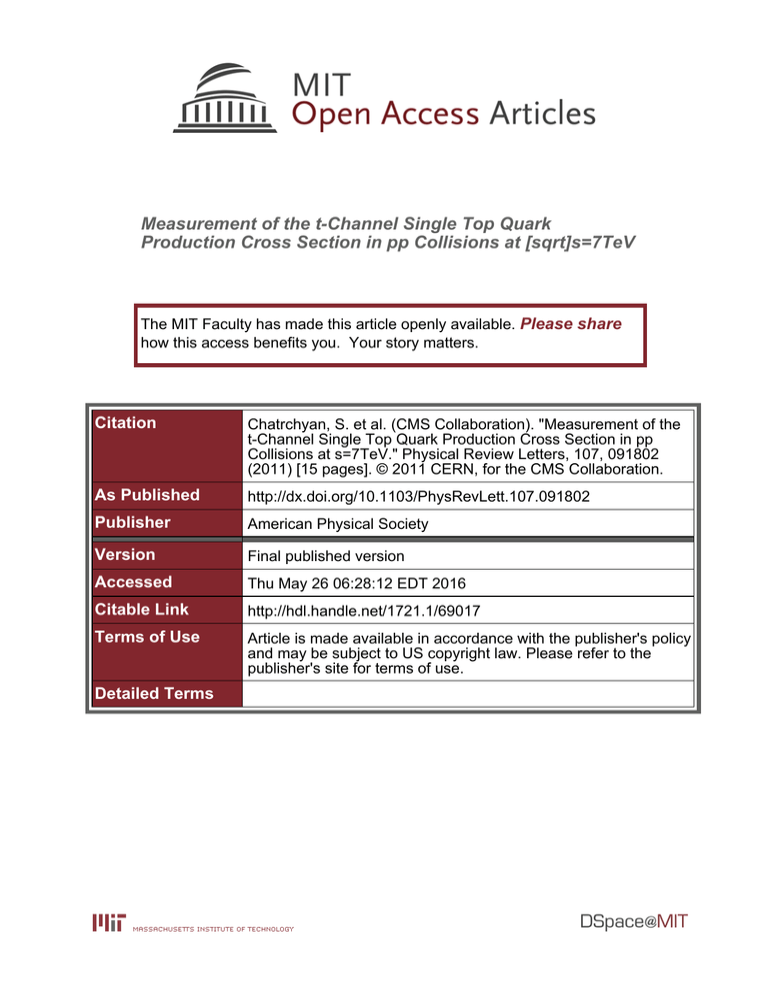
Measurement of the t-Channel Single Top Quark Production Cross Section in pp Collisions at [sqrt]s=7TeV The MIT Faculty has made this article openly available. Please share how this access benefits you. Your story matters. Citation Chatrchyan, S. et al. (CMS Collaboration). "Measurement of the t-Channel Single Top Quark Production Cross Section in pp Collisions at s=7TeV." Physical Review Letters, 107, 091802 (2011) [15 pages]. © 2011 CERN, for the CMS Collaboration. As Published http://dx.doi.org/10.1103/PhysRevLett.107.091802 Publisher American Physical Society Version Final published version Accessed Thu May 26 06:28:12 EDT 2016 Citable Link http://hdl.handle.net/1721.1/69017 Terms of Use Article is made available in accordance with the publisher's policy and may be subject to US copyright law. Please refer to the publisher's site for terms of use. Detailed Terms PRL 107, 091802 (2011) PHYSICAL REVIEW LETTERS week ending 26 AUGUST 2011 Measurement of the t-Channel Single ToppffiffiQuark Production Cross Section ffi in pp Collisions at s ¼ 7 TeV S. Chatrchyan et al.* (CMS Collaboration) (Received 16 June 2011; published 25 August 2011) pffiffiffi Electroweak production of the top quark is measured for the first time in pp collisions at s ¼ 7 TeV, using a data set collected with the CMS detector at the LHC and corresponding to an integrated luminosity of 36 pb1 . With an event selection optimized for t-channel production, two complementary analyses are performed. The first one exploits the special angular properties of the signal, together with background estimates from the data. The second approach uses a multivariate analysis technique to probe the compatibility with signal topology expected from electroweak top-quark production. The combined measurement of the cross section is 83:6 29:8ðstat þ systÞ 3:3ðlumiÞ pb, consistent with the standard model expectation. DOI: 10.1103/PhysRevLett.107.091802 PACS numbers: 13.85.Ni, 12.15.Ji, 14.65.Ha Electroweak theory predicts three mechanisms for single-top quark production in hadron-hadron collisions: t-channel, s-channel, and tW (or W-associated) production. Single-top events have been observed by the D0 and CDF experiments at the Tevatron pp collider [1–3], and first measurements of individual channels have recently been reported [4–6]. In proton-proton collisions at 7 TeV, t-channel single-top quark production, Fig. 1, has the largest cross section and the cleanest final-state topology, because of the presence of a light jet recoiling against the single-top quark. In the standard model (SM), next-toleading order (NLO) computations with resummation of collinear and soft-gluon corrections at next-to-next-toleading logarithmic accuracy predict t ¼ 64:3þ2:1þ1:5 0:71:7 pb [7], for a top mass of mt ¼ 173 GeV=c2 and with parton distribution functions (PDFs) as given in Ref. [8]. The first uncertainty comes from doubling and halving the renormalization and factorization scales and the second from PDF uncertainty at the 90% confidence level. The singletop cross section measurement can be used as a test of the Cabibbo-Kobayashi-Maskawa matrix unitarity [9], of the PDFs and of the higher-order corrections from quantum chromodynamics. Departures from the SM prediction are expected in several new physics scenarios, for example, in models with flavor-changing neutral currents (FCNCs) or anomalous top-quark couplings [10]. This Letter presents the first measurement of the t-channel single-top quark production cross section in pp pffiffiffi collisions at s ¼ 7 TeV in the decay channels t ! eb, t ! b, and t ! b with leptonic decays. Two complementary measurements are performed. The first analysis exploits two angular observables sensitive to t-channel single-top quark production: the noncentral pseudorapidity distribution of the light jet, and the cosine of the angle between this jet and the final-state lepton, in the reconstructed top-quark rest frame. A multivariate analysis technique with boosted decision trees (BDTs) [11,12] is used in the second method, which probes the overall compatibility of the signal event candidates with the event topology of electroweak top-quark production. Hereafter, these analyses will be referred to as 2D analysis and BDT analysis, respectively. The 2D analysis is the first single-top quark measurement that does not depend on multivariate techniques. Both analyses use a data sample corresponding to an integrated luminosity of 35:9 1:4 pb1 [13], collected by the Compact Muon Solenoid (CMS) detector [14] operating at the Large Hadron Collider (LHC). The central feature of the CMS detector is a superconducting solenoid providing a field of 3.8 T. Located within the solenoid are the silicon pixel and strip tracker, the crystal electromagnetic calorimeter, and the brass or scintillator hadron calorimeter. Muons are measured in gas-ionization detectors embedded in the steel return yoke. In addition to the barrel and end cap detectors, a quartz-fiber Cherenkov *Full author list given at the end of the article. Published by the American Physical Society under the terms of the Creative Commons Attribution 3.0 License. Further distribution of this work must maintain attribution to the author(s) and the published article’s title, journal citation, and DOI. 0031-9007=11=107(9)=091802(15) FIG. 1. Feynman diagrams for single-top quark production in t channel: 2 ! 2 (left) and 2 ! 3 (right) processes. 091802-1 Ó 2011 CERN, for the CMS Collaboration PRL 107, 091802 (2011) PHYSICAL REVIEW LETTERS detector extends the jet acceptance to jj ¼ 5, where the pseudorapidity is defined as ¼ ln tan2 , where is the polar angle of the particle or jet trajectory with respect to the counterclockwise beam direction. Events are selected by requiring the presence of at least one muon or electron having high transverse momentum (pT ). The particle flow (PF) algorithm described in [15] performs a global event reconstruction and provides the full list of particles identified as electrons, muons, photons, charged and neutral hadrons. A fully reconstructed isolated muon (electron) candidate originating from the leading primary vertex is required [16] with pT > 20ð30Þ GeV=c, jj < 2:1 (2.5), and a veto is applied on additional leptons passing lower thresholds. Jets are reconstructed using the anti-kT algorithm [17] with a distance parameter of 0.5, clustering particles identified by the PF algorithm. Jets within the full calorimeter acceptance are considered, with pT > 30 GeV=c after corrections for the jet energy scale, as determined from simulations and collision data [18]. The BDT analysis first identifies isolated leptons, which are then excluded for the jet clustering step. In the 2D analysis, possible jetlepton ambiguities are resolved on the basis of the distance pffiffiffiffiffiffiffiffiffiffiffiffiffiffiffiffiffiffiffiffiffiffiffiffiffiffiffiffiffiffiffiffiffi R ðÞ2 þ ðÞ2 between the reconstructed jet and the nearest lepton [16]. The event is accepted for further analysis only if exactly two jets are reconstructed. In order to reduce the large background from W þ light partons, we apply a b-tagging algorithm [19] that calculates the signed 3D impact-parameter (IP) significance (IP=IP ) of all the tracks, passing tight quality criteria, associated with the jet. The tracks are ordered decreasingly, following their value of IP=IP , and a tight selection threshold is applied on the impact-parameter significance of the third track in the list. This threshold corresponds to a b-jet identification efficiency of 40% and a misidentification rate of 0:1%. The efficiency and misidentification probability are determined in the data as a function of pT and [19]. The 2D analysis exploits the expectation that most of the signal events, even in the 2 ! 3 process, have only one b quark inside the tracking acceptance (jj < 2:4). Events are rejected if the jet failing the tight threshold passes a loose threshold on the IP significance of the second track. The loose threshold corresponds to an efficiency and misidentification rate of about 80% and 10%, respectively. The BDT analysis applies no veto on the second b-tagged jet, and rejects events where the jets are backto-back, which are found to be poorly reproduced by the W þ jets simulation. To further suppress contributions from processes where the muon (electron) does not come from the decay of a W boson, we require a transverse mass of the W boson MT > 40ð50Þ GeV=c2 , where the transverse missing energy (Emiss T ) from the PF algorithm is used as a measurement of the pT of the undetected neutrino. No is applied. cut on Emiss T week ending 26 AUGUST 2011 The 2D analysis selects 112 (72) events in the muon (electron) decay channel, while the BDT analysis selects 139 (82). In both analyses a signal purity of around 18% (16%) is expected in the muon (electron) decay channel. W þ light-partons, The main backgrounds are tt, Wbb, Wc, tW, and processes where the lepton does not originate from a W=Z, hereafter called QCD events. The t-channel events from Monte Carlo simulation used in this study have been generated with the MADGRAPH 4.4 event generator [20]. To give a fair approximation of the full next-to-leading order properties of the signal, we combine the dominant NLO contribution (2 ! 3 diagram qg ! q0 tb and its charge conjugate) with the leading order diagram (2 ! 2, qb ! q0 t) by a matching procedure based on Ref. [21]. MADGRAPH is used also for tt, single-top s and tW channels, and W=Z þ jets. Di-boson production (WW, WZ, ZZ) is simulated using PYTHIA 6.4.22 [22]. The CTEQ 6.6 PDF sets [23] are used for all simulated samples. All generated events undergo a full simulation of the detector response based on GEANT4 [24]. The NLO theoretical prediction is used to normalize the single-top production in s and tW channels [25,26] and diboson processes [27]. The tt cross section is normalized to 150 pb, constrained using the uncertainty from the result of a dedicated analysis. The same analysis constrains the VQQ (V ¼ W, Z and Q ¼ b, c) and Wc components, obtaining, in particular, a factor of 2 1 for Wbb over the LO prediction. The QCD yield is estimated from the same data set by a maximum likelihood fit to the MT distribution after all other selection criteria have been applied. The MT distribution for QCD events is taken from a control sample obtained by inverting the lepton isolation requirement. The latter requirement rejects most of the signal-like events (single top, W=Z þ jets, tt) leaving a QCDdominated sample. The distribution for the sum of all non-QCD processes is taken from simulation. The uncertainty on this estimate is conservatively estimated such as to cover the differences observed when varying the fit range and the QCD shape. The BDT analysis normalizes the result of the W þ jets simulation to the inclusive W cross section at next-to-nextto-leading order (NNLO) [27], while the collision data are used in the 2D analysis to extract the normalization of the W þ light-partons background. Two control samples are used, orthogonal to the standard selection. Control sample ‘‘region A,’’ dominated by the W þ light partons background, is defined by the requirement of one isolated lepton and exactly two jets, one of which is required to be within the tracker acceptance and with at least two tracks satisfying the quality selection of the b-tagging algorithm. Both jets should fail the tight b-tagging selection. A second control sample, ‘‘region B,’’ is defined as a subset of the former where at least one jet passes the loose b-tagging selection although it fails the tight one. In both samples a fit 091802-2 week ending 26 AUGUST 2011 PHYSICAL REVIEW LETTERS 35 CMS, 36 pb-1, s = 7 TeV 30 25 Events of the MT distribution is performed, allowing the QCD and W þ light-partons background to float, while all other processes, including heavy-flavor contributions and the t-channel signal, are constrained to their expected values. A scale factor of 1.27 in the muon and 1.05 in the electron decay channel is observed between the number of W þ light-partons events obtained from the fit in sample region B and the predictions from simulation. These scale factors are used to obtain the central value of the predicted background. A 30% ( 20%) uncertainty is assigned on the muon (electron) scale factor, covering both the statistical uncertainty from the fit, the difference between the background predictions obtained from the two control samples, region-A and region-B, and between data and simulation results for both samples. The normalization of Z þ jets background is rescaled by the same factor as that for the W þ light-parton background. A top-quark candidate is reconstructed in each event by pairing the b-tagged jet with a W-boson candidate. The latter is reconstructed by imposing the W-boson mass as a kinematic constraint, leading to a quadratic equation in the longitudinal neutrino momentum, pz; . When two real solutions are found the smallest jpz; j is taken, and for complex solutions the imaginary component is eliminated miss by modifying Emiss T;x and ET;y independently, such as to give MT ¼ MW [28]. In the 2D analysis a two-dimensional maximum likelihood fit is performed. One of the two fit variables is the cosine of the angle between the direction of the outgoing lepton and the spin axis, approximated by the direction of the untagged jet, in the top-quark rest frame [29,30]. This observable has a distinct slope in signal events, coming from the almost 100% polarization of the top-quark due to the V-A structure of the electroweak interaction [31]. This property holds true also in many theories beyond the SM [32]. The other fit variable is the pseudorapidity distribution of the untagged jet, light jet , interpreted as the light quark jet recoiling against the single top, whose characteristic distribution allows a discrimination against the typically central jets from the main background processes. The distributions in cos and light jet are shown in Fig. 2 for events passing the 2D selection. The inputs to the fit are the distributions for the signal and backgrounds in the cos -light jet plane, separately in the muon and electron decay channels. The overall background is allowed to float unconstrained in the fit, while its relative components are fixed according to the background estimates. The QCD and W þ light-partons shapes are taken from the anti-isolated and region-A control samples described above, respectively, while all others are taken from the simulation. The BDT method combines a given set of observables into one single classifier variable bdt. A total of 37 observables have been chosen. Their selection has been inspired by the D0 analysis [33] and optimized for the LHC 20 15 10 5 0 -1 -0.8 -0.6 -0.4 -0.2 0 0.2 0.4 0.6 0.8 1 cos θ* 50 CMS, 36 pb-1, s = 7 TeV data t channel 40 tW + s ch. tt Events PRL 107, 091802 (2011) 30 Wbb+Wcc Wc W+light jets 20 QCD Other 10 0 0 0.5 1 1.5 2 2.5 |η 3 3.5 4 4.5 5 | light jet FIG. 2 (color online). Cosine of the angle between the charged lepton and the untagged jet ( cos , top panel) and pseudorapidity of the untagged jet (light jet , bottom panel) after the 2D selection, for both electron and muon decay channels. QCD and W þ light-partons events are normalized to the data, tt, VQQ (V ¼ W, Z and Q ¼ b, c), and Wc are normalized to the result of a dedicated measurement, all other processes are normalized to theoretical expectations. kinematics. The most discriminant ones are the lepton momentum, the mass of the system formed by the reconstructed W boson and the two jets, the pT of the system formed by the two jets, the pT of the jet passing tight b-tagging requirements, and the reconstructed top-quark mass. The validity of the description of all the input variables in the simulation has been checked using a Kolmogorov-Smirnov test in a W-enriched control sample with no b-tagged jet, shown in Fig. 3 (top). The bdt classifier has been validated both in simulation and in the data: negligible differences are found by comparing its distribution for signal events with MADGRAPH, SINGLETOP [21], and MC@NLO 3.4 [34], and for tt events with MADGRAPH, PYTHIA and MC@NLO. In the W-enriched control sample the distribution of bdt from the simulation is statistically compatible with the data. The cross section is extracted from binned bdt distributions using a Bayesian approach with a uniformly 091802-3 PHYSICAL REVIEW LETTERS PRL 107, 091802 (2011) CMS, 36 pb-1, s = 7 TeV 1800 1600 Events 1400 Q variation 1200 1000 800 600 400 200 0 -1 -0.8 -0.6 -0.4 -0.2 0 0.2 0.4 0.6 0.8 1 bdt CMS, 36 pb-1, s = 7 TeV 70 data t channel Events 60 tW + s ch. tt 50 Wbb+Wcc 40 Wc 30 W+light jets QCD 20 Other 10 0 -1 -0.8 -0.6 -0.4 -0.2 0 0.2 0.4 0.6 0.8 1 bdt FIG. 3 (color online). Boosted decision tree discriminant (bdt) for both electron and muon decay channels in the W-enriched control sample (top panel), with simulation normalized to the data, also shown for W þ jets samples with doubled and halved renormalization and factorization scales (Q). Same observable after the complete BDT selection (bottom panel), with the signal scaled to the measured cross section and all systematic uncertainties and backgrounds scaled to the medians of their posterior distributions. distributed positive prior. The normalizations of the backgrounds and the other systematic uncertainties are treated as nuisance parameters. The measured distribution of the classifier bdt is shown in Fig. 3 (bottom). The following sources of systematic uncertainties are common to both analyses: background normalization; jet meaenergy scale [18], propagated coherently to the Emiss T surement; calibration of the unclustered energy deposits contributing to Emiss T , varied by 10%; b-tagging and mistagging efficiencies [19]; modeling of the signal and of the main backgrounds; and a 4% uncertainty on the integrated luminosity [13]. The uncertainty on the signal model is estimated by comparing MADGRAPH and SINGLETOP events with different fragmentation models. The uncertainty on the tt and W=Z þ jets models is determined by comparing simulated samples with varied renormalization and factorization scales (within half and double the nominal values, independently for tt and for W=Z þ jets), initial- and final-state week ending 26 AUGUST 2011 radiation parameters, and two different fragmentation models. The impact of pileup is estimated by comparing the default simulated samples with no pileup and dedicated samples where minimum bias interactions are superimposed with a probability distribution roughly corresponding to the one observed in the overall 2010 data set. The shapes of the bdt classifier and of both variables used in the 2D analysis are negligibly affected. In the 2D analysis a conservative systematic uncertainty is assigned to the degree of correlation between light jet and cos (estimated as 6% from simulation) by comparing to the result obtained using the product of uncorrelated one-dimensional distributions for the signal. The W þ light-partons background shapes in light jet and cos are extracted from the data in the 2D analysis, and studies with simulated events show that the shapes extracted from the control sample are statistically consistent with those in the signal region for the same process. Nevertheless, a small difference is observed in the light jet shapes in the two selections for the Wc process, and we conservatively consider this difference as a systematic uncertainty on all W þ jets processes. The efficiencies of the muon and electron triggers, identification, and isolation for the 2D selection have been evaluated from the data using dilepton events at the Z peak [16]. The uncertainties on these efficiencies have a negligible effect on this analysis. The impact of each individual source of uncertainty on both analyses has been estimated with an ensemble of pseudoexperiments. The dominant systematic uncertainty on the cross section determination comes from the b-tagging efficiency, known within 15%, because of its large effect on the signal acceptance. Nevertheless, this source has a negligible effect on the shapes of the final discriminant variables in both analyses. Other important systematic uncertainties come from the signal model, the factorization or renormalization scale for W=Z þ jets, the jet energy scale, and the Wc background. Table I shows the cross section measured by both analyses in each decay channel, corrected for acceptance and branching ratios. In the muon þ electron combination all systematic uncertainties are considered fully correlated, with the exception of the uncertainty on multijet QCD obtained from the data. All measurements are consistent among each other and with the SM expectation. Under the assumption that all uncertainties are Gaussian and symmetric, which is fulfilled by the dominant uncertainties, the 2D and BDT cross section measurements are combined with the BLUE technique [35], taking into account a statistical correlation of 51% estimated with pseudoexperiments, and treating all the systematic uncertainties as fully correlated with the exceptions of those coming from estimates based on the data. The combined result is exp ¼ 83:6 29:8ðstat þ systÞ 3:3ðlumiÞ pb 091802-4 PRL 107, 091802 (2011) PHYSICAL REVIEW LETTERS TABLE I. Cross section measurements by channel and by analysis. The first uncertainty is statistical, the second systematic. An additional 4% uncertainty on the luminosity [13] for each measurement is not included. Channel e þe 2D analysis 104:1 154:2 124:2 week ending 26 AUGUST 2011 MICINN and CPAN (Spain); Swiss Funding Agencies (Switzerland); NSC (Taipei); TUBITAK and TAEK (Turkey); STFC (United Kingdom); DOE and NSF (USA). BDT analysis 42:3þ24:8 28:0 56:0þ40:6 46:6 33:8þ30:0 33:9 þ16:5 pb 90:4 35:119:7 pb þ13:1 pb 59:2 35:113:7 pb þ13:2 pb 78:7 25:414:6 pb combined: 83:6 29:8 pb where the BDT analysis contributes with the largest weight (89%). The expected and observed significances, including systematic uncertainties, are estimated with an ensemble of pseudoexperiments. The probability of the predicted background distributions to fluctuate to the observed data corresponds to 3.7 (3.5) Gaussian standard deviations in the 2D (BDT) analysis, combining the electron and muon þ1:0 decay channels, while 2:1þ1:0 1:1 (2:90:9 ) are expected when assuming SM t-channel production cross section. The combined significance is well approximated by the BDT significance of 3.5 Gaussian standard deviations. We infer an effective value of jVtb j under the assumption that jVtd j and jVts j are much smaller than jVtb j, and qffiffiffiffiffiffi ffi exp therefore that jVtb j ¼ th ¼ 1:14 0:22ðexpÞ 0:02ðthÞ where th is the SM prediction under the jVtb j ¼ 1 assumption. Using the SM assumption that 0 jVtb j2 1, at the 95% confidence level we infer the lower bound jVtb j > 0:62 (0.68) from the 2D (BDT) analysis, respectively. In summary, we confirm the Tevatron observation of single-top quark production and present the first measurement of the t-channel single-top pffiffiffi quark production cross section in pp collisions at s ¼ 7 TeV, finding a good agreement with the SM prediction [7]. We wish to congratulate our colleagues in the CERN accelerator departments for the excellent performance of the LHC machine. We thank the technical and administrative staff at CERN and other CMS institutes, and acknowledge support from: FMSR (Austria); FNRS and FWO (Belgium); CNPq, CAPES, FAPERJ, and FAPESP (Brazil); MES (Bulgaria); CERN; CAS, MoST, and NSFC (China); COLCIENCIAS (Colombia); MSES (Croatia); RPF (Cyprus); Academy of Sciences and NICPB (Estonia); Academy of Finland, ME, and HIP (Finland); CEA and CNRS/IN2P3 (France); BMBF, DFG, and HGF (Germany); GSRT (Greece); OTKA and NKTH (Hungary); DAE and DST (India); IPM (Iran); SFI (Ireland); INFN (Italy); NRF and WCU (Korea); LAS (Lithuania); CINVESTAV, CONACYT, SEP, and UASLPFAI (Mexico); PAEC (Pakistan); SCSR (Poland); FCT (Portugal); JINR (Armenia, Belarus, Georgia, Ukraine, Uzbekistan); MST and MAE (Russia); MSTD (Serbia); [1] V. M. Abazov et al. (D0), Phys. Rev. Lett. 103, 092001 (2009). [2] T. Aaltonen et al. (CDF Collaboration), Phys. Rev. Lett. 103, 092002 (2009). [3] Tevatron Electroweak Working Group (CDF) and (D0), arXiv:0908.2171. [4] V. M. Abazov et al. (D0), Phys. Lett. B 682, 363 (2010). [5] V. M. Abazov et al. (D0 Collaboration), arXiv:1105.2788. [6] T. Aaltonen et al. (CDF Collaboration), Phys. Rev. D 82, 112005 (2010). [7] N. Kidonakis, Phys. Rev. D 83, 091503(R)(2011). [8] A. D. Martin et al., Eur. Phys. J. C 63, 189 (2009). [9] J. Alwall et al., Eur. Phys. J. C 49, 791 (2007). [10] T. M. P. Tait and C.-P. Yuan, Phys. Rev. D 63, 014018 (2000). [11] L. Breiman et al., Classication and Regression Trees (Wadsworth and Brooks, Monterey, CA, 1984). [12] Y. Freund and E. Schapire, Proceedings of the Thirteenth International Conference on Machine Learning (Morgan Kaufmann Publishers, San Francisco, CA, 1996), p. 148. [13] CMS Collaboration (CMS), Report No. CMS-DP-11-002, 2011. [14] S. Chatrchyan et al. (CMS), JINST 3, S08004 (2008). [15] CMS Collaboration (CMS), Report No. CMS-PAS-PFT09-001, 2009. [16] CMS Collaboration (CMS), arXiv:1106.0902 [Eur. Phys. J. C (to be published)]. [17] M. Cacciari, G. P. Salam, and G. Soyez, J. High Energy Phys. 04 (2008) 063. [18] CMS Collaboration (CMS), Report No. CMS-PAS-JME10-010, 2010. [19] CMS Collaboration (CMS), Report No. CMS-PAS-BTV10-001, 2010. [20] F. Maltoni and T. Stelzer, J. High Energy Phys. 02 (2003) 027. [21] E. Boos et al., Phys. At. Nucl. 69, 1317 (2006). [22] T. Sjostrand et al., J. High Energy Phys. 05 (2006) 026. [23] J. Pumplin et al., J. High Energy Phys. 07 (2002) 012. [24] J. Allison et al., IEEE Trans. Nucl. Sci. 53, 270 (2006). [25] N. Kidonakis, Phys. Rev. D 81, 054028 (2010). [26] J. Campbell and F. Tramontano, Nucl. Phys. B 726, 109 (2005). [27] R. Gavin et al., arXiv:1011.3540. [28] J. Bauer, Ph.D. thesis, Karlsruher Institut für Technologie, 2010. [29] G. Mahlon and S. Parke, Phys. Rev. D 55, 7249 (1997). [30] P. Motylinski, Phys. Rev. D 80, 074015 (2009). [31] G. Mahlon and S. J. Parke, Phys. Lett. B 476, 323 (2000). [32] S. Batebi, S. M. Etesami, and M. MohammadiNajafabadi, Phys. Rev. D 83, 057502 (2011). [33] V. M. Abazov et al. (D0), Phys. Rev. D 78, 012005 (2008). [34] S. Frixione and B. R. Webber, J. High Energy Phys. 06 (2002) 029. [35] L. Lyons, D. Gibaut, and P. Cliord, Nucl. Instrum. Methods Phys. Res., Sect. A 270, 110 (1988). 091802-5 PRL 107, 091802 (2011) PHYSICAL REVIEW LETTERS week ending 26 AUGUST 2011 S. Chatrchyan,1 V. Khachatryan,1 A. M. Sirunyan,1 A. Tumasyan,1 W. Adam,2 T. Bergauer,2 M. Dragicevic,2 J. Erö,2 C. Fabjan,2 M. Friedl,2 R. Frühwirth,2 V. M. Ghete,2 J. Hammer,2,b S. Hänsel,2 M. Hoch,2 N. Hörmann,2 J. Hrubec,2 M. Jeitler,2 W. Kiesenhofer,2 M. Krammer,2 D. Liko,2 I. Mikulec,2 M. Pernicka,2 H. Rohringer,2 R. Schöfbeck,2 J. Strauss,2 A. Taurok,2 F. Teischinger,2 P. Wagner,2 W. Waltenberger,2 G. Walzel,2 E. Widl,2 C.-E. Wulz,2 V. Mossolov,3 N. Shumeiko,3 J. Suarez Gonzalez,3 S. Bansal,4 L. Benucci,4 E. A. De Wolf,4 X. Janssen,4 J. Maes,4 T. Maes,4 L. Mucibello,4 S. Ochesanu,4 B. Roland,4 R. Rougny,4 M. Selvaggi,4 H. Van Haevermaet,4 P. Van Mechelen,4 N. Van Remortel,4 F. Blekman,5 S. Blyweert,5 J. D’Hondt,5 O. Devroede,5 R. Gonzalez Suarez,5 A. Kalogeropoulos,5 M. Maes,5 W. Van Doninck,5 P. Van Mulders,5 G. P. Van Onsem,5 I. Villella,5 O. Charaf,6 B. Clerbaux,6 G. De Lentdecker,6 V. Dero,6 A. P. R. Gay,6 G. H. Hammad,6 T. Hreus,6 P. E. Marage,6 L. Thomas,6 C. Vander Velde,6 P. Vanlaer,6 V. Adler,7 A. Cimmino,7 S. Costantini,7 M. Grunewald,7 B. Klein,7 J. Lellouch,7 A. Marinov,7 J. Mccartin,7 D. Ryckbosch,7 F. Thyssen,7 M. Tytgat,7 L. Vanelderen,7 P. Verwilligen,7 S. Walsh,7 N. Zaganidis,7 S. Basegmez,8 G. Bruno,8 J. Caudron,8 L. Ceard,8 E. Cortina Gil,8 J. De Favereau De Jeneret,8 C. Delaere,8,b D. Favart,8 A. Giammanco,8 G. Grégoire,8 J. Hollar,8 V. Lemaitre,8 J. Liao,8 O. Militaru,8 C. Nuttens,8 S. Ovyn,8 D. Pagano,8 A. Pin,8 K. Piotrzkowski,8 N. Schul,8 N. Beliy,9 T. Caebergs,9 E. Daubie,9 G. A. Alves,10 L. Brito,10 D. De Jesus Damiao,10 M. E. Pol,10 M. H. G. Souza,10 W. L. Aldá Júnior,11 W. Carvalho,11 E. M. Da Costa,11 C. De Oliveira Martins,11 S. Fonseca De Souza,11 L. Mundim,11 H. Nogima,11 V. Oguri,11 W. L. Prado Da Silva,11 A. Santoro,11 S. M. Silva Do Amaral,11 A. Sznajder,11 C. A. Bernardes,12,c F. A. Dias,12 T. R. Fernandez Perez Tomei,12 E. M. Gregores,12,c C. Lagana,12 F. Marinho,12 P. G. Mercadante,12,c S. F. Novaes,12 Sandra S. Padula,12 N. Darmenov,13,b V. Genchev,13,b P. Iaydjiev,13,b S. Piperov,13 M. Rodozov,13 S. Stoykova,13 G. Sultanov,13 V. Tcholakov,13 R. Trayanov,13 A. Dimitrov,14 R. Hadjiiska,14 A. Karadzhinova,14 V. Kozhuharov,14 L. Litov,14 M. Mateev,14 B. Pavlov,14 P. Petkov,14 J. G. Bian,15 G. M. Chen,15 H. S. Chen,15 C. H. Jiang,15 D. Liang,15 S. Liang,15 X. Meng,15 J. Tao,15 J. Wang,15 J. Wang,15 X. Wang,15 Z. Wang,15 H. Xiao,15 M. Xu,15 J. Zang,15 Z. Zhang,15 Y. Ban,16 S. Guo,16 Y. Guo,16 W. Li,16 Y. Mao,16 S. J. Qian,16 H. Teng,16 B. Zhu,16 W. Zou,16 A. Cabrera,17 B. Gomez Moreno,17 A. A. Ocampo Rios,17 A. F. Osorio Oliveros,17 J. C. Sanabria,17 N. Godinovic,18 D. Lelas,18 K. Lelas,18 R. Plestina,18,d D. Polic,18 I. Puljak,18 Z. Antunovic,19 M. Dzelalija,19 V. Brigljevic,20 S. Duric,20 K. Kadija,20 S. Morovic,20 A. Attikis,21 M. Galanti,21 J. Mousa,21 C. Nicolaou,21 F. Ptochos,21 P. A. Razis,21 M. Finger,22 M. Finger, Jr.,22 Y. Assran,23,e S. Khalil,23,f M. A. Mahmoud,23,g A. Hektor,24 M. Kadastik,24 M. Müntel,24 M. Raidal,24 L. Rebane,24 A. Tiko,24 V. Azzolini,25 P. Eerola,25 G. Fedi,25 S. Czellar,26 J. Härkönen,26 A. Heikkinen,26 V. Karimäki,26 R. Kinnunen,26 M. J. Kortelainen,26 T. Lampén,26 K. Lassila-Perini,26 S. Lehti,26 T. Lindén,26 P. Luukka,26 T. Mäenpää,26 E. Tuominen,26 J. Tuominiemi,26 E. Tuovinen,26 D. Ungaro,26 L. Wendland,26 K. Banzuzi,27 A. Karjalainen,27 A. Korpela,27 T. Tuuva,27 D. Sillou,28 M. Besancon,29 S. Choudhury,29 M. Dejardin,29 D. Denegri,29 B. Fabbro,29 J. L. Faure,29 F. Ferri,29 S. Ganjour,29 F. X. Gentit,29 A. Givernaud,29 P. Gras,29 G. Hamel de Monchenault,29 P. Jarry,29 E. Locci,29 J. Malcles,29 M. Marionneau,29 L. Millischer,29 J. Rander,29 A. Rosowsky,29 I. Shreyber,29 M. Titov,29 P. Verrecchia,29 S. Baffioni,30 F. Beaudette,30 L. Benhabib,30 L. Bianchini,30 M. Bluj,30,h C. Broutin,30 P. Busson,30 C. Charlot,30 T. Dahms,30 L. Dobrzynski,30 S. Elgammal,30 R. Granier de Cassagnac,30 M. Haguenauer,30 P. Miné,30 C. Mironov,30 C. Ochando,30 P. Paganini,30 D. Sabes,30 R. Salerno,30 Y. Sirois,30 C. Thiebaux,30 B. Wyslouch,30,i A. Zabi,30 J.-L. Agram,31,j J. Andrea,31 D. Bloch,31 D. Bodin,31 J.-M. Brom,31 M. Cardaci,31 E. C. Chabert,31 C. Collard,31 E. Conte,31,j F. Drouhin,31,j C. Ferro,31 J.-C. Fontaine,31,j D. Gelé,31 U. Goerlach,31 S. Greder,31 P. Juillot,31 M. Karim,31,j A.-C. Le Bihan,31 Y. Mikami,31 P. Van Hove,31 F. Fassi,32 D. Mercier,32 C. Baty,33 S. Beauceron,33 N. Beaupere,33 M. Bedjidian,33 O. Bondu,33 G. Boudoul,33 D. Boumediene,33 H. Brun,33 J. Chasserat,33 R. Chierici,33 D. Contardo,33 P. Depasse,33 H. El Mamouni,33 J. Fay,33 S. Gascon,33 B. Ille,33 T. Kurca,33 T. Le Grand,33 M. Lethuillier,33 L. Mirabito,33 S. Perries,33 V. Sordini,33 S. Tosi,33 Y. Tschudi,33 P. Verdier,33 D. Lomidze,34 G. Anagnostou,35 S. Beranek,35 M. Edelhoff,35 L. Feld,35 N. Heracleous,35 O. Hindrichs,35 R. Jussen,35 K. Klein,35 J. Merz,35 N. Mohr,35 A. Ostapchuk,35 A. Perieanu,35 F. Raupach,35 J. Sammet,35 S. Schael,35 D. Sprenger,35 H. Weber,35 M. Weber,35 B. Wittmer,35 M. Ata,36 E. Dietz-Laursonn,36 M. Erdmann,36 R. Fischer,36 T. Hebbeker,36 A. Hinzmann,36 K. Hoepfner,36 R. S. Höing,36 T. Klimkovich,36 D. Klingebiel,36 P. Kreuzer,36 D. Lanske,36,a J. Lingemann,36 C. Magass,36 M. Merschmeyer,36 A. Meyer,36 P. Papacz,36 H. Pieta,36 H. Reithler,36 S. A. Schmitz,36 L. Sonnenschein,36 J. Steggemann,36 D. Teyssier,36 M. Bontenackels,37 M. Davids,37 M. Duda,37 G. Flügge,37 091802-6 PRL 107, 091802 (2011) PHYSICAL REVIEW LETTERS week ending 26 AUGUST 2011 H. Geenen,37 M. Giffels,37 W. Haj Ahmad,37 D. Heydhausen,37 F. Hoehle,37 B. Kargoll,37 T. Kress,37 Y. Kuessel,37 A. Linn,37 A. Nowack,37 L. Perchalla,37 O. Pooth,37 J. Rennefeld,37 P. Sauerland,37 A. Stahl,37 M. Thomas,37 D. Tornier,37 M. H. Zoeller,37 M. Aldaya Martin,38 W. Behrenhoff,38 U. Behrens,38 M. Bergholz,38,k A. Bethani,38 K. Borras,38 A. Cakir,38 A. Campbell,38 E. Castro,38 D. Dammann,38 G. Eckerlin,38 D. Eckstein,38 A. Flossdorf,38 G. Flucke,38 A. Geiser,38 J. Hauk,38 H. Jung,38,b M. Kasemann,38 I. Katkov,38,l P. Katsas,38 C. Kleinwort,38 H. Kluge,38 A. Knutsson,38 M. Krämer,38 D. Krücker,38 E. Kuznetsova,38 W. Lange,38 W. Lohmann,38,k R. Mankel,38 M. Marienfeld,38 I.-A. Melzer-Pellmann,38 A. B. Meyer,38 J. Mnich,38 A. Mussgiller,38 J. Olzem,38 A. Petrukhin,38 D. Pitzl,38 A. Raspereza,38 A. Raval,38 M. Rosin,38 R. Schmidt,38,k T. Schoerner-Sadenius,38 N. Sen,38 A. Spiridonov,38 M. Stein,38 J. Tomaszewska,38 R. Walsh,38 C. Wissing,38 C. Autermann,39 V. Blobel,39 S. Bobrovskyi,39 J. Draeger,39 H. Enderle,39 U. Gebbert,39 M. Görner,39 K. Kaschube,39 G. Kaussen,39 H. Kirschenmann,39 R. Klanner,39 J. Lange,39 B. Mura,39 S. Naumann-Emme,39 F. Nowak,39 N. Pietsch,39 C. Sander,39 H. Schettler,39 P. Schleper,39 E. Schlieckau,39 M. Schröder,39 T. Schum,39 J. Schwandt,39 H. Stadie,39 G. Steinbrück,39 J. Thomsen,39 C. Barth,40 J. Bauer,40 J. Berger,40 V. Buege,40 T. Chwalek,40 W. De Boer,40 A. Dierlamm,40 G. Dirkes,40 M. Feindt,40 J. Gruschke,40 C. Hackstein,40 F. Hartmann,40 M. Heinrich,40 H. Held,40 K. H. Hoffmann,40 S. Honc,40 J. R. Komaragiri,40 T. Kuhr,40 D. Martschei,40 S. Mueller,40 Th. Müller,40 M. Niegel,40 O. Oberst,40 A. Oehler,40 J. Ott,40 T. Peiffer,40 G. Quast,40 K. Rabbertz,40 F. Ratnikov,40 N. Ratnikova,40 M. Renz,40 S. Röcker,40 C. Saout,40 A. Scheurer,40 P. Schieferdecker,40 F.-P. Schilling,40 G. Schott,40 H. J. Simonis,40 F. M. Stober,40 D. Troendle,40 J. Wagner-Kuhr,40 T. Weiler,40 M. Zeise,40 V. Zhukov,40,l E. B. Ziebarth,40 G. Daskalakis,41 T. Geralis,41 S. Kesisoglou,41 A. Kyriakis,41 D. Loukas,41 I. Manolakos,41 A. Markou,41 C. Markou,41 C. Mavrommatis,41 E. Ntomari,41 E. Petrakou,41 L. Gouskos,42 T. J. Mertzimekis,42 A. Panagiotou,42 E. Stiliaris,42 I. Evangelou,43 C. Foudas,43 P. Kokkas,43 N. Manthos,43 I. Papadopoulos,43 V. Patras,43 F. A. Triantis,43 A. Aranyi,44 G. Bencze,44 L. Boldizsar,44 C. Hajdu,44,b P. Hidas,44 D. Horvath,44,m A. Kapusi,44 K. Krajczar,44,n F. Sikler,44,b G. I. Veres,44,n G. Vesztergombi,44,n N. Beni,45 J. Molnar,45 J. Palinkas,45 Z. Szillasi,45 V. Veszpremi,45 P. Raics,46 Z. L. Trocsanyi,46 B. Ujvari,46 S. B. Beri,47 V. Bhatnagar,47 N. Dhingra,47 R. Gupta,47 M. Jindal,47 M. Kaur,47 J. M. Kohli,47 M. Z. Mehta,47 N. Nishu,47 L. K. Saini,47 A. Sharma,47 A. P. Singh,47 J. Singh,47 S. P. Singh,47 S. Ahuja,48 B. C. Choudhary,48 P. Gupta,48 S. Jain,48 A. Kumar,48 A. Kumar,48 M. Naimuddin,48 K. Ranjan,48 R. K. Shivpuri,48 S. Banerjee,49 S. Bhattacharya,49 S. Dutta,49 B. Gomber,49 S. Jain,49 R. Khurana,49 S. Sarkar,49 R. K. Choudhury,50 D. Dutta,50 S. Kailas,50 V. Kumar,50 P. Mehta,50 A. K. Mohanty,50,b L. M. Pant,50 P. Shukla,50 T. Aziz,51 M. Guchait,51,o A. Gurtu,51 M. Maity,51,p D. Majumder,51 G. Majumder,51 K. Mazumdar,51 G. B. Mohanty,51 A. Saha,51 K. Sudhakar,51 N. Wickramage,51 S. Banerjee,52 S. Dugad,52 N. K. Mondal,52 H. Arfaei,53 H. Bakhshiansohi,53,q S. M. Etesami,53 A. Fahim,53,q M. Hashemi,53 A. Jafari,53,q M. Khakzad,53 A. Mohammadi,53,r M. Mohammadi Najafabadi,53 S. Paktinat Mehdiabadi,53 B. Safarzadeh,53 M. Zeinali,53,s M. Abbrescia,54a,54b L. Barbone,54a,54b C. Calabria,54a,54b A. Colaleo,54a D. Creanza,54a,54c N. De Filippis,54a,54c,b M. De Palma,54a,54b L. Fiore,54a G. Iaselli,54a,54c L. Lusito,54a,54b G. Maggi,54a,54c M. Maggi,54a N. Manna,54a,54b B. Marangelli,54a,54b S. My,54a,54c S. Nuzzo,54a,54b N. Pacifico,54a,54b G. A. Pierro,54a A. Pompili,54a,54b G. Pugliese,54a,54c F. Romano,54a,54c G. Roselli,54a,54b G. Selvaggi,54a,54b L. Silvestris,54a R. Trentadue,54a S. Tupputi,54a,54b G. Zito,54a G. Abbiendi,55a A. C. Benvenuti,55a D. Bonacorsi,55a S. Braibant-Giacomelli,55a,55b L. Brigliadori,55a P. Capiluppi,55a,55b A. Castro,55a,55b F. R. Cavallo,55a M. Cuffiani,55a,55b G. M. Dallavalle,55a F. Fabbri,55a A. Fanfani,55a,55b D. Fasanella,55a P. Giacomelli,55a M. Giunta,55a C. Grandi,55a S. Marcellini,55a G. Masetti,55b M. Meneghelli,55a,55b A. Montanari,55a F. L. Navarria,55a,55b F. Odorici,55a A. Perrotta,55a F. Primavera,55a A. M. Rossi,55a,55b T. Rovelli,55a,55b G. Siroli,55a,55b R. Travaglini,55a,55b S. Albergo,56a,56b G. Cappello,56a,56b M. Chiorboli,56a,56b,b S. Costa,56a,56b A. Tricomi,56a,56b C. Tuve,56a,56b G. Barbagli,57a V. Ciulli,57a,57b C. Civinini,57a R. D’Alessandro,57a,57b E. Focardi,57a,57b S. Frosali,57a,57b E. Gallo,57a S. Gonzi,57a,57b P. Lenzi,57a,57b M. Meschini,57a S. Paoletti,57a G. Sguazzoni,57a A. Tropiano,57a,b L. Benussi,58 S. Bianco,58 S. Colafranceschi,58,t F. Fabbri,58 D. Piccolo,58 P. Fabbricatore,59 R. Musenich,59 A. Benaglia,60a,60b F. De Guio,60a,60b,b L. Di Matteo,60a,60b S. Gennai,60a,b A. Ghezzi,60a,60b S. Malvezzi,60a A. Martelli,60a,60b A. Massironi,60a,60b D. Menasce,60a L. Moroni,60a M. Paganoni,60a,60b D. Pedrini,60a S. Ragazzi,60a,60b N. Redaelli,60a S. Sala,60a T. Tabarelli de Fatis,60a,60b S. Buontempo,61a C. A. Carrillo Montoya,61a,b N. Cavallo,61a,u A. De Cosa,61a,61b F. Fabozzi,61a,u A. O. M. Iorio,61a,b L. Lista,61a M. Merola,61a,61b P. Paolucci,61a P. Azzi,62a N. Bacchetta,62a P. Bellan,62a,62b D. Bisello,62a,62b A. Branca,62a R. Carlin,62a,62b P. Checchia,62a T. Dorigo,62a U. Dosselli,62a F. Fanzago,62a F. Gasparini,62a,62b U. Gasparini,62a,62b A. Gozzelino,62a S. Lacaprara,62a 091802-7 PRL 107, 091802 (2011) PHYSICAL REVIEW LETTERS week ending 26 AUGUST 2011 I. Lazzizzera,62a,62c M. Margoni,62a,62b M. Mazzucato,62a A. T. Meneguzzo,62a,62b M. Nespolo,62a,b L. Perrozzi,62a,b N. Pozzobon,62a,62b P. Ronchese,62a,62b F. Simonetto,62a,62b E. Torassa,62a M. Tosi,62a,62b S. Vanini,62a,62b P. Zotto,62a,62b G. Zumerle,62a,62b P. Baesso,63a,63b U. Berzano,63a S. P. Ratti,63a,63b C. Riccardi,63a,63b P. Torre,63a,63b P. Vitulo,63a,63b C. Viviani,63a,63b M. Biasini,64a,64b G. M. Bilei,64a B. Caponeri,64a,64b L. Fanò,64a,64b P. Lariccia,64a,64b A. Lucaroni,64a,64b,b G. Mantovani,64a,64b M. Menichelli,64a A. Nappi,64a,64b F. Romeo,64a,64b A. Santocchia,64a,64b S. Taroni,64a,64b,b M. Valdata,64a,64b P. Azzurri,65a,65c G. Bagliesi,65a J. Bernardini,65a,65b T. Boccali,65a,b G. Broccolo,65a,65c R. Castaldi,65a R. T. D’Agnolo,65a,65c R. Dell’Orso,65a F. Fiori,65a,65b L. Foà,65a,65c A. Giassi,65a A. Kraan,65a F. Ligabue,65a,65c T. Lomtadze,65a L. Martini,65a,v A. Messineo,65a,65b F. Palla,65a G. Segneri,65a A. T. Serban,65a P. Spagnolo,65a R. Tenchini,65a G. Tonelli,65a,65b,b A. Venturi,65a,b P. G. Verdini,65a L. Barone,66a,66b F. Cavallari,66a D. Del Re,66a,66b E. Di Marco,66a,66b M. Diemoz,66a D. Franci,66a,66b M. Grassi,66a,b E. Longo,66a,66b P. Meridiani,66a S. Nourbakhsh,66a G. Organtini,66a,66b F. Pandolfi,66a,66b,b R. Paramatti,66a S. Rahatlou,66a,66b C. Rovelli,66a,b N. Amapane,67a,67b R. Arcidiacono,67a,67c S. Argiro,67a,67b M. Arneodo,67a,67c C. Biino,67a C. Botta,67a,67b,b N. Cartiglia,67a R. Castello,67a,67b M. Costa,67a,67b N. Demaria,67a A. Graziano,67a,67b,b C. Mariotti,67a M. Marone,67a,67b S. Maselli,67a E. Migliore,67a,67b G. Mila,67a,67b V. Monaco,67a,67b M. Musich,67a,67b M. M. Obertino,67a,67c N. Pastrone,67a M. Pelliccioni,67a,67b A. Potenza,67a,67b A. Romero,67a,67b M. Ruspa,67a,67c R. Sacchi,67a,67b V. Sola,67a,67b A. Solano,67a,67b A. Staiano,67a A. Vilela Pereira,67a S. Belforte,68a F. Cossutti,68a G. Della Ricca,68a,68b B. Gobbo,68a D. Montanino,68a,68b A. Penzo,68a S. G. Heo,69 S. K. Nam,69 S. Chang,70 J. Chung,70 D. H. Kim,70 G. N. Kim,70 J. E. Kim,70 D. J. Kong,70 H. Park,70 S. R. Ro,70 D. Son,70 D. C. Son,70 T. Son,70 Zero Kim,71 J. Y. Kim,71 S. Song,71 S. Choi,72 B. Hong,72 M. Jo,72 H. Kim,72 J. H. Kim,72 T. J. Kim,72 K. S. Lee,72 D. H. Moon,72 S. K. Park,72 K. S. Sim,72 M. Choi,73 S. Kang,73 H. Kim,73 C. Park,73 I. C. Park,73 S. Park,73 G. Ryu,73 Y. Choi,74 Y. K. Choi,74 J. Goh,74 M. S. Kim,74 J. Lee,74 S. Lee,74 H. Seo,74 I. Yu,74 M. J. Bilinskas,75 I. Grigelionis,75 M. Janulis,75 D. Martisiute,75 P. Petrov,75 T. Sabonis,75 H. Castilla-Valdez,76 E. De La Cruz-Burelo,76 I. Heredia-de La Cruz,76 R. Lopez-Fernandez,76 R. Magaña Villalba,76 A. Sánchez-Hernández,76 L. M. Villasenor-Cendejas,76 S. Carrillo Moreno,77 F. Vazquez Valencia,77 H. A. Salazar Ibarguen,78 E. Casimiro Linares,79 A. Morelos Pineda,79 M. A. Reyes-Santos,79 D. Krofcheck,80 J. Tam,80 P. H. Butler,81 R. Doesburg,81 H. Silverwood,81 M. Ahmad,82 I. Ahmed,82 M. I. Asghar,82 H. R. Hoorani,82 W. A. Khan,82 T. Khurshid,82 S. Qazi,82 G. Brona,83 M. Cwiok,83 W. Dominik,83 K. Doroba,83 A. Kalinowski,83 M. Konecki,83 J. Krolikowski,83 T. Frueboes,84 R. Gokieli,84 M. Górski,84 M. Kazana,84 K. Nawrocki,84 K. Romanowska-Rybinska,84 M. Szleper,84 G. Wrochna,84 P. Zalewski,84 N. Almeida,85 P. Bargassa,85 A. David,85 P. Faccioli,85 P. G. Ferreira Parracho,85 M. Gallinaro,85 P. Musella,85 A. Nayak,85 J. Pela,85,b P. Q. Ribeiro,85 J. Seixas,85 J. Varela,85 S. Afanasiev,86 I. Belotelov,86 P. Bunin,86 I. Golutvin,86 A. Kamenev,86 V. Karjavin,86 G. Kozlov,86 A. Lanev,86 P. Moisenz,86 V. Palichik,86 V. Perelygin,86 S. Shmatov,86 V. Smirnov,86 A. Volodko,86 A. Zarubin,86 V. Golovtsov,87 Y. Ivanov,87 V. Kim,87 P. Levchenko,87 V. Murzin,87 V. Oreshkin,87 I. Smirnov,87 V. Sulimov,87 L. Uvarov,87 S. Vavilov,87 A. Vorobyev,87 An. Vorobyev,87 Yu. Andreev,88 A. Dermenev,88 S. Gninenko,88 N. Golubev,88 M. Kirsanov,88 N. Krasnikov,88 V. Matveev,88 A. Pashenkov,88 A. Toropin,88 S. Troitsky,88 V. Epshteyn,89 V. Gavrilov,89 V. Kaftanov,89,a M. Kossov,89,b A. Krokhotin,89 N. Lychkovskaya,89 V. Popov,89 G. Safronov,89 S. Semenov,89 V. Stolin,89 E. Vlasov,89 A. Zhokin,89 E. Boos,90 M. Dubinin,90,w L. Dudko,90 A. Ershov,90 A. Gribushin,90 O. Kodolova,90 I. Lokhtin,90 A. Markina,90 S. Obraztsov,90 M. Perfilov,90 S. Petrushanko,90 L. Sarycheva,90 V. Savrin,90 A. Snigirev,90 V. Andreev,91 M. Azarkin,91 I. Dremin,91 M. Kirakosyan,91 A. Leonidov,91 S. V. Rusakov,91 A. Vinogradov,91 I. Azhgirey,92 I. Bayshev,92 S. Bitioukov,92 V. Grishin,92,b V. Kachanov,92 D. Konstantinov,92 A. Korablev,92 V. Krychkine,92 V. Petrov,92 R. Ryutin,92 A. Sobol,92 L. Tourtchanovitch,92 S. Troshin,92 N. Tyurin,92 A. Uzunian,92 A. Volkov,92 P. Adzic,93,x M. Djordjevic,93 D. Krpic,93,x J. Milosevic,93 M. Aguilar-Benitez,94 J. Alcaraz Maestre,94 P. Arce,94 C. Battilana,94 E. Calvo,94 M. Cepeda,94 M. Cerrada,94 M. Chamizo Llatas,94 N. Colino,94 B. De La Cruz,94 A. Delgado Peris,94 C. Diez Pardos,94 D. Domı́nguez Vázquez,94 C. Fernandez Bedoya,94 J. P. Fernández Ramos,94 A. Ferrando,94 J. Flix,94 M. C. Fouz,94 P. Garcia-Abia,94 O. Gonzalez Lopez,94 S. Goy Lopez,94 J. M. Hernandez,94 M. I. Josa,94 G. Merino,94 J. Puerta Pelayo,94 I. Redondo,94 L. Romero,94 J. Santaolalla,94 M. S. Soares,94 C. Willmott,94 C. Albajar,95 G. Codispoti,95 J. F. de Trocóniz,95 J. Cuevas,96 J. Fernandez Menendez,96 S. Folgueras,96 I. Gonzalez Caballero,96 L. Lloret Iglesias,96 J. M. Vizan Garcia,96 J. A. Brochero Cifuentes,97 I. J. Cabrillo,97 A. Calderon,97 S. H. Chuang,97 J. Duarte Campderros,97 M. Felcini,97,y M. Fernandez,97 G. Gomez,97 J. Gonzalez Sanchez,97 C. Jorda,97 P. Lobelle Pardo,97 A. Lopez Virto,97 J. Marco,97 R. Marco,97 091802-8 PRL 107, 091802 (2011) PHYSICAL REVIEW LETTERS week ending 26 AUGUST 2011 C. Martinez Rivero,97 F. Matorras,97 F. J. Munoz Sanchez,97 J. Piedra Gomez,97,z T. Rodrigo,97 A. Y. Rodrı́guez-Marrero,97 A. Ruiz-Jimeno,97 L. Scodellaro,97 M. Sobron Sanudo,97 I. Vila,97 R. Vilar Cortabitarte,97 D. Abbaneo,98 E. Auffray,98 G. Auzinger,98 P. Baillon,98 A. H. Ball,98 D. Barney,98 A. J. Bell,98,aa D. Benedetti,98 C. Bernet,98,d W. Bialas,98 P. Bloch,98 A. Bocci,98 S. Bolognesi,98 M. Bona,98 H. Breuker,98 K. Bunkowski,98 T. Camporesi,98 G. Cerminara,98 T. Christiansen,98 J. A. Coarasa Perez,98 B. Curé,98 D. D’Enterria,98 A. De Roeck,98 S. Di Guida,98 N. Dupont-Sagorin,98 A. Elliott-Peisert,98 B. Frisch,98 W. Funk,98 A. Gaddi,98 G. Georgiou,98 H. Gerwig,98 D. Gigi,98 K. Gill,98 D. Giordano,98 F. Glege,98 R. Gomez-Reino Garrido,98 M. Gouzevitch,98 P. Govoni,98 S. Gowdy,98 L. Guiducci,98 M. Hansen,98 C. Hartl,98 J. Harvey,98 J. Hegeman,98 B. Hegner,98 H. F. Hoffmann,98 A. Honma,98 V. Innocente,98 P. Janot,98 K. Kaadze,98 E. Karavakis,98 P. Lecoq,98 C. Lourenço,98 T. Mäki,98 M. Malberti,98 L. Malgeri,98 M. Mannelli,98 L. Masetti,98 A. Maurisset,98 F. Meijers,98 S. Mersi,98 E. Meschi,98 R. Moser,98 M. U. Mozer,98 M. Mulders,98 E. Nesvold,98,b M. Nguyen,98 T. Orimoto,98 L. Orsini,98 E. Perez,98 A. Petrilli,98 A. Pfeiffer,98 M. Pierini,98 M. Pimiä,98 D. Piparo,98 G. Polese,98 A. Racz,98 W. Reece,98 J. Rodrigues Antunes,98 G. Rolandi,98,bb T. Rommerskirchen,98 M. Rovere,98 H. Sakulin,98 C. Schäfer,98 C. Schwick,98 I. Segoni,98 A. Sharma,98 P. Siegrist,98 M. Simon,98 P. Sphicas,98,cc M. Spiropulu,98,w M. Stoye,98 P. Tropea,98 A. Tsirou,98 P. Vichoudis,98 M. Voutilainen,98 W. D. Zeuner,98 W. Bertl,99 K. Deiters,99 W. Erdmann,99 K. Gabathuler,99 R. Horisberger,99 Q. Ingram,99 H. C. Kaestli,99 S. König,99 D. Kotlinski,99 U. Langenegger,99 F. Meier,99 D. Renker,99 T. Rohe,99 J. Sibille,99,dd A. Starodumov,99,ee L. Bäni,100 P. Bortignon,100 L. Caminada,100,ff N. Chanon,100 Z. Chen,100 S. Cittolin,100 G. Dissertori,100 M. Dittmar,100 J. Eugster,100 K. Freudenreich,100 C. Grab,100 W. Hintz,100 P. Lecomte,100 W. Lustermann,100 C. Marchica,100,ff P. Martinez Ruiz del Arbol,100 P. Milenovic,100,gg F. Moortgat,100 C. Nägeli,100,ff P. Nef,100 F. Nessi-Tedaldi,100 L. Pape,100 F. Pauss,100 T. Punz,100 A. Rizzi,100 F. J. Ronga,100 M. Rossini,100 L. Sala,100 A. K. Sanchez,100 M.-C. Sawley,100 B. Stieger,100 L. Tauscher,100,a A. Thea,100 K. Theofilatos,100 D. Treille,100 C. Urscheler,100 R. Wallny,100 M. Weber,100 L. Wehrli,100 J. Weng,100 E. Aguilo,101 C. Amsler,101 V. Chiochia,101 S. De Visscher,101 C. Favaro,101 M. Ivova Rikova,101 B. Millan Mejias,101 P. Otiougova,101 C. Regenfus,101 P. Robmann,101 A. Schmidt,101 H. Snoek,101 Y. H. Chang,102 K. H. Chen,102 C. M. Kuo,102 S. W. Li,102 W. Lin,102 Z. K. Liu,102 Y. J. Lu,102 D. Mekterovic,102 R. Volpe,102 J. H. Wu,102 S. S. Yu,102 P. Bartalini,103 P. Chang,103 Y. H. Chang,103 Y. W. Chang,103 Y. Chao,103 K. F. Chen,103 W.-S. Hou,103 Y. Hsiung,103 K. Y. Kao,103 Y. J. Lei,103 R.-S. Lu,103 J. G. Shiu,103 Y. M. Tzeng,103 M. Wang,103 A. Adiguzel,104 M. N. Bakirci,104,hh S. Cerci,104,ii C. Dozen,104 I. Dumanoglu,104 E. Eskut,104 S. Girgis,104 G. Gokbulut,104 I. Hos,104 E. E. Kangal,104 A. Kayis Topaksu,104 G. Onengut,104 K. Ozdemir,104 S. Ozturk,104,jj A. Polatoz,104 K. Sogut,104,kk D. Sunar Cerci,104,ii B. Tali,104,ii H. Topakli,104,hh D. Uzun,104 L. N. Vergili,104 M. Vergili,104 I. V. Akin,105 T. Aliev,105 B. Bilin,105 S. Bilmis,105 M. Deniz,105 H. Gamsizkan,105 A. M. Guler,105 K. Ocalan,105 A. Ozpineci,105 M. Serin,105 R. Sever,105 U. E. Surat,105 E. Yildirim,105 M. Zeyrek,105 M. Deliomeroglu,106 D. Demir,106,ll E. Gülmez,106 B. Isildak,106 M. Kaya,106,mm O. Kaya,106,mm M. Özbek,106 S. Ozkorucuklu,106,nn N. Sonmez,106,oo L. Levchuk,107 F. Bostock,108 J. J. Brooke,108 T. L. Cheng,108 E. Clement,108 D. Cussans,108 R. Frazier,108 J. Goldstein,108 M. Grimes,108 D. Hartley,108 G. P. Heath,108 H. F. Heath,108 L. Kreczko,108 S. Metson,108 D. M. Newbold,108,pp K. Nirunpong,108 A. Poll,108 S. Senkin,108 V. J. Smith,108 L. Basso,109,qq K. W. Bell,109 A. Belyaev,109,qq C. Brew,109 R. M. Brown,109 B. Camanzi,109 D. J. A. Cockerill,109 J. A. Coughlan,109 K. Harder,109 S. Harper,109 J. Jackson,109 B. W. Kennedy,109 E. Olaiya,109 D. Petyt,109 B. C. Radburn-Smith,109 C. H. Shepherd-Themistocleous,109 I. R. Tomalin,109 W. J. Womersley,109 S. D. Worm,109 R. Bainbridge,110 G. Ball,110 J. Ballin,110 R. Beuselinck,110 O. Buchmuller,110 D. Colling,110 N. Cripps,110 M. Cutajar,110 G. Davies,110 M. Della Negra,110 W. Ferguson,110 J. Fulcher,110 D. Futyan,110 A. Gilbert,110 A. Guneratne Bryer,110 G. Hall,110 Z. Hatherell,110 J. Hays,110 G. Iles,110 M. Jarvis,110 G. Karapostoli,110 L. Lyons,110 B. C. MacEvoy,110 A.-M. Magnan,110 J. Marrouche,110 B. Mathias,110 R. Nandi,110 J. Nash,110 A. Nikitenko,110,ee A. Papageorgiou,110 M. Pesaresi,110 K. Petridis,110 M. Pioppi,110,rr D. M. Raymond,110 S. Rogerson,110 N. Rompotis,110 A. Rose,110 M. J. Ryan,110 C. Seez,110 P. Sharp,110 A. Sparrow,110 A. Tapper,110 S. Tourneur,110 M. Vazquez Acosta,110 T. Virdee,110 S. Wakefield,110 N. Wardle,110 D. Wardrope,110 T. Whyntie,110 M. Barrett,111 M. Chadwick,111 J. E. Cole,111 P. R. Hobson,111 A. Khan,111 P. Kyberd,111 D. Leslie,111 W. Martin,111 I. D. Reid,111 L. Teodorescu,111 K. Hatakeyama,112 H. Liu,112 C. Henderson,113 T. Bose,114 E. Carrera Jarrin,114 C. Fantasia,114 A. Heister,114 J. St. John,114 P. Lawson,114 D. Lazic,114 J. Rohlf,114 D. Sperka,114 L. Sulak,114 A. Avetisyan,115 S. Bhattacharya,115 J. P. Chou,115 D. Cutts,115 A. Ferapontov,115 U. Heintz,115 S. Jabeen,115 G. Kukartsev,115 G. Landsberg,115 M. Luk,115 M. Narain,115 D. Nguyen,115 M. Segala,115 T. Sinthuprasith,115 091802-9 PRL 107, 091802 (2011) PHYSICAL REVIEW LETTERS week ending 26 AUGUST 2011 T. Speer,115 K. V. Tsang,115 R. Breedon,116 G. Breto,116 M. Calderon De La Barca Sanchez,116 S. Chauhan,116 M. Chertok,116 J. Conway,116 P. T. Cox,116 J. Dolen,116 R. Erbacher,116 E. Friis,116 W. Ko,116 A. Kopecky,116 R. Lander,116 H. Liu,116 S. Maruyama,116 T. Miceli,116 M. Nikolic,116 D. Pellett,116 J. Robles,116 S. Salur,116 T. Schwarz,116 M. Searle,116 J. Smith,116 M. Squires,116 M. Tripathi,116 R. Vasquez Sierra,116 C. Veelken,116 V. Andreev,117 K. Arisaka,117 D. Cline,117 R. Cousins,117 A. Deisher,117 J. Duris,117 S. Erhan,117 C. Farrell,117 J. Hauser,117 M. Ignatenko,117 C. Jarvis,117 C. Plager,117 G. Rakness,117 P. Schlein,117,a J. Tucker,117 V. Valuev,117 J. Babb,118 A. Chandra,118 R. Clare,118 J. Ellison,118 J. W. Gary,118 F. Giordano,118 G. Hanson,118 G. Y. Jeng,118 S. C. Kao,118 F. Liu,118 H. Liu,118 O. R. Long,118 A. Luthra,118 H. Nguyen,118 B. C. Shen,118,a R. Stringer,118 J. Sturdy,118 S. Sumowidagdo,118 R. Wilken,118 S. Wimpenny,118 W. Andrews,119 J. G. Branson,119 G. B. Cerati,119 D. Evans,119 F. Golf,119 A. Holzner,119 R. Kelley,119 M. Lebourgeois,119 J. Letts,119 B. Mangano,119 S. Padhi,119 C. Palmer,119 G. Petrucciani,119 H. Pi,119 M. Pieri,119 R. Ranieri,119 M. Sani,119 V. Sharma,119 S. Simon,119 E. Sudano,119 M. Tadel,119 Y. Tu,119 A. Vartak,119 S. Wasserbaech,119,ss F. Würthwein,119 A. Yagil,119 J. Yoo,119 D. Barge,120 R. Bellan,120 C. Campagnari,120 M. D’Alfonso,120 T. Danielson,120 K. Flowers,120 P. Geffert,120 J. Incandela,120 C. Justus,120 P. Kalavase,120 S. A. Koay,120 D. Kovalskyi,120 V. Krutelyov,120 S. Lowette,120 N. Mccoll,120 V. Pavlunin,120 F. Rebassoo,120 J. Ribnik,120 J. Richman,120 R. Rossin,120 D. Stuart,120 W. To,120 J. R. Vlimant,120 A. Apresyan,121 A. Bornheim,121 J. Bunn,121 Y. Chen,121 M. Gataullin,121 Y. Ma,121 A. Mott,121 H. B. Newman,121 C. Rogan,121 K. Shin,121 V. Timciuc,121 P. Traczyk,121 J. Veverka,121 R. Wilkinson,121 Y. Yang,121 R. Y. Zhu,121 B. Akgun,122 R. Carroll,122 T. Ferguson,122 Y. Iiyama,122 D. W. Jang,122 S. Y. Jun,122 Y. F. Liu,122 M. Paulini,122 J. Russ,122 H. Vogel,122 I. Vorobiev,122 J. P. Cumalat,123 M. E. Dinardo,123 B. R. Drell,123 C. J. Edelmaier,123 W. T. Ford,123 A. Gaz,123 B. Heyburn,123 E. Luiggi Lopez,123 U. Nauenberg,123 J. G. Smith,123 K. Stenson,123 K. A. Ulmer,123 S. R. Wagner,123 S. L. Zang,123 L. Agostino,124 J. Alexander,124 D. Cassel,124 A. Chatterjee,124 N. Eggert,124 L. K. Gibbons,124 B. Heltsley,124 W. Hopkins,124 A. Khukhunaishvili,124 B. Kreis,124 G. Nicolas Kaufman,124 J. R. Patterson,124 D. Puigh,124 A. Ryd,124 M. Saelim,124 E. Salvati,124 X. Shi,124 W. Sun,124 W. D. Teo,124 J. Thom,124 J. Thompson,124 J. Vaughan,124 Y. Weng,124 L. Winstrom,124 P. Wittich,124 A. Biselli,125 G. Cirino,125 D. Winn,125 S. Abdullin,126 M. Albrow,126 J. Anderson,126 G. Apollinari,126 M. Atac,126 J. A. Bakken,126 L. A. T. Bauerdick,126 A. Beretvas,126 J. Berryhill,126 P. C. Bhat,126 I. Bloch,126 F. Borcherding,126 K. Burkett,126 J. N. Butler,126 V. Chetluru,126 H. W. K. Cheung,126 F. Chlebana,126 S. Cihangir,126 W. Cooper,126 D. P. Eartly,126 V. D. Elvira,126 S. Esen,126 I. Fisk,126 J. Freeman,126 Y. Gao,126 E. Gottschalk,126 D. Green,126 K. Gunthoti,126 O. Gutsche,126 J. Hanlon,126 R. M. Harris,126 J. Hirschauer,126 B. Hooberman,126 H. Jensen,126 M. Johnson,126 U. Joshi,126 R. Khatiwada,126 B. Klima,126 K. Kousouris,126 S. Kunori,126 S. Kwan,126 C. Leonidopoulos,126 P. Limon,126 D. Lincoln,126 R. Lipton,126 J. Lykken,126 K. Maeshima,126 J. M. Marraffino,126 D. Mason,126 P. McBride,126 T. Miao,126 K. Mishra,126 S. Mrenna,126 Y. Musienko,126,tt C. Newman-Holmes,126 V. O’Dell,126 R. Pordes,126 O. Prokofyev,126 N. Saoulidou,126 E. Sexton-Kennedy,126 S. Sharma,126 W. J. Spalding,126 L. Spiegel,126 P. Tan,126 L. Taylor,126 S. Tkaczyk,126 L. Uplegger,126 E. W. Vaandering,126 R. Vidal,126 J. Whitmore,126 W. Wu,126 F. Yang,126 F. Yumiceva,126 J. C. Yun,126 D. Acosta,127 P. Avery,127 D. Bourilkov,127 M. Chen,127 S. Das,127 M. De Gruttola,127 G. P. Di Giovanni,127 D. Dobur,127 A. Drozdetskiy,127 R. D. Field,127 M. Fisher,127 Y. Fu,127 I. K. Furic,127 J. Gartner,127 B. Kim,127 J. Konigsberg,127 A. Korytov,127 A. Kropivnitskaya,127 T. Kypreos,127 K. Matchev,127 G. Mitselmakher,127 L. Muniz,127 C. Prescott,127 R. Remington,127 A. Rinkevicius,127 M. Schmitt,127 B. Scurlock,127 P. Sellers,127 N. Skhirtladze,127 M. Snowball,127 D. Wang,127 J. Yelton,127 M. Zakaria,127 V. Gaultney,128 L. Kramer,128 L. M. Lebolo,128 S. Linn,128 P. Markowitz,128 G. Martinez,128 J. L. Rodriguez,128 T. Adams,129 A. Askew,129 J. Bochenek,129 J. Chen,129 B. Diamond,129 S. V. Gleyzer,129 J. Haas,129 S. Hagopian,129 V. Hagopian,129 M. Jenkins,129 K. F. Johnson,129 H. Prosper,129 L. Quertenmont,129 S. Sekmen,129 V. Veeraraghavan,129 M. M. Baarmand,130 B. Dorney,130 S. Guragain,130 M. Hohlmann,130 H. Kalakhety,130 R. Ralich,130 I. Vodopiyanov,130 M. R. Adams,131 I. M. Anghel,131 L. Apanasevich,131 Y. Bai,131 V. E. Bazterra,131 R. R. Betts,131 J. Callner,131 R. Cavanaugh,131 C. Dragoiu,131 L. Gauthier,131 C. E. Gerber,131 D. J. Hofman,131 S. Khalatyan,131 G. J. Kunde,131 F. Lacroix,131 M. Malek,131 C. O’Brien,131 C. Silkworth,131 C. Silvestre,131 A. Smoron,131 D. Strom,131 N. Varelas,131 U. Akgun,132 E. A. Albayrak,132 B. Bilki,132 W. Clarida,132 F. Duru,132 C. K. Lae,132 E. McCliment,132 J.-P. Merlo,132 H. Mermerkaya,132,uu A. Mestvirishvili,132 A. Moeller,132 J. Nachtman,132 C. R. Newsom,132 E. Norbeck,132 J. Olson,132 Y. Onel,132 F. Ozok,132 S. Sen,132 J. Wetzel,132 T. Yetkin,132 K. Yi,132 B. A. Barnett,133 B. Blumenfeld,133 A. Bonato,133 C. Eskew,133 D. Fehling,133 G. Giurgiu,133 A. V. Gritsan,133 Z. J. Guo,133 G. Hu,133 P. Maksimovic,133 091802-10 PRL 107, 091802 (2011) PHYSICAL REVIEW LETTERS week ending 26 AUGUST 2011 S. Rappoccio,133 M. Swartz,133 N. V. Tran,133 A. Whitbeck,133 P. Baringer,134 A. Bean,134 G. Benelli,134 O. Grachov,134 R. P. Kenny Iii,134 M. Murray,134 D. Noonan,134 S. Sanders,134 J. S. Wood,134 V. Zhukova,134 A. F. Barfuss,135 T. Bolton,135 I. Chakaberia,135 A. Ivanov,135 S. Khalil,135 M. Makouski,135 Y. Maravin,135 S. Shrestha,135 I. Svintradze,135 Z. Wan,135 J. Gronberg,136 D. Lange,136 D. Wright,136 A. Baden,137 M. Boutemeur,137 S. C. Eno,137 D. Ferencek,137 J. A. Gomez,137 N. J. Hadley,137 R. G. Kellogg,137 M. Kirn,137 Y. Lu,137 A. C. Mignerey,137 K. Rossato,137 P. Rumerio,137 F. Santanastasio,137 A. Skuja,137 J. Temple,137 M. B. Tonjes,137 S. C. Tonwar,137 E. Twedt,137 B. Alver,138 G. Bauer,138 J. Bendavid,138 W. Busza,138 E. Butz,138 I. A. Cali,138 M. Chan,138 V. Dutta,138 P. Everaerts,138 G. Gomez Ceballos,138 M. Goncharov,138 K. A. Hahn,138 P. Harris,138 Y. Kim,138 M. Klute,138 Y.-J. Lee,138 W. Li,138 C. Loizides,138 P. D. Luckey,138 T. Ma,138 S. Nahn,138 C. Paus,138 D. Ralph,138 C. Roland,138 G. Roland,138 M. Rudolph,138 G. S. F. Stephans,138 F. Stöckli,138 K. Sumorok,138 K. Sung,138 E. A. Wenger,138 R. Wolf,138 S. Xie,138 M. Yang,138 Y. Yilmaz,138 A. S. Yoon,138 M. Zanetti,138 S. I. Cooper,139 P. Cushman,139 B. Dahmes,139 A. De Benedetti,139 P. R. Dudero,139 G. Franzoni,139 J. Haupt,139 K. Klapoetke,139 Y. Kubota,139 J. Mans,139 N. Pastika,139 V. Rekovic,139 R. Rusack,139 M. Sasseville,139 A. Singovsky,139 N. Tambe,139 L. M. Cremaldi,140 R. Godang,140 R. Kroeger,140 L. Perera,140 R. Rahmat,140 D. A. Sanders,140 D. Summers,140 K. Bloom,141 S. Bose,141 J. Butt,141 D. R. Claes,141 A. Dominguez,141 M. Eads,141 J. Keller,141 T. Kelly,141 I. Kravchenko,141 J. Lazo-Flores,141 H. Malbouisson,141 S. Malik,141 G. R. Snow,141 U. Baur,142 A. Godshalk,142 I. Iashvili,142 S. Jain,142 A. Kharchilava,142 A. Kumar,142 S. P. Shipkowski,142 K. Smith,142 J. Zennamo,142 G. Alverson,143 E. Barberis,143 D. Baumgartel,143 O. Boeriu,143 M. Chasco,143 S. Reucroft,143 J. Swain,143 D. Trocino,143 D. Wood,143 J. Zhang,143 A. Anastassov,144 A. Kubik,144 N. Odell,144 R. A. Ofierzynski,144 B. Pollack,144 A. Pozdnyakov,144 M. Schmitt,144 S. Stoynev,144 M. Velasco,144 S. Won,144 L. Antonelli,145 D. Berry,145 A. Brinkerhoff,145 M. Hildreth,145 C. Jessop,145 D. J. Karmgard,145 J. Kolb,145 T. Kolberg,145 K. Lannon,145 W. Luo,145 S. Lynch,145 N. Marinelli,145 D. M. Morse,145 T. Pearson,145 R. Ruchti,145 J. Slaunwhite,145 N. Valls,145 M. Wayne,145 J. Ziegler,145 B. Bylsma,146 L. S. Durkin,146 J. Gu,146 C. Hill,146 P. Killewald,146 K. Kotov,146 T. Y. Ling,146 M. Rodenburg,146 G. Williams,146 N. Adam,147 E. Berry,147 P. Elmer,147 D. Gerbaudo,147 V. Halyo,147 P. Hebda,147 A. Hunt,147 J. Jones,147 E. Laird,147 D. Lopes Pegna,147 D. Marlow,147 T. Medvedeva,147 M. Mooney,147 J. Olsen,147 P. Piroué,147 X. Quan,147 B. Safdi,147 H. Saka,147 D. Stickland,147 C. Tully,147 J. S. Werner,147 A. Zuranski,147 J. G. Acosta,148 X. T. Huang,148 A. Lopez,148 H. Mendez,148 S. Oliveros,148 J. E. Ramirez Vargas,148 A. Zatserklyaniy,148 E. Alagoz,149 V. E. Barnes,149 G. Bolla,149 L. Borrello,149 D. Bortoletto,149 M. De Mattia,149 A. Everett,149 A. F. Garfinkel,149 L. Gutay,149 Z. Hu,149 M. Jones,149 O. Koybasi,149 M. Kress,149 A. T. Laasanen,149 N. Leonardo,149 C. Liu,149 V. Maroussov,149 P. Merkel,149 D. H. Miller,149 N. Neumeister,149 I. Shipsey,149 D. Silvers,149 A. Svyatkovskiy,149 H. D. Yoo,149 J. Zablocki,149 Y. Zheng,149 P. Jindal,150 N. Parashar,150 C. Boulahouache,151 K. M. Ecklund,151 F. J. M. Geurts,151 B. P. Padley,151 R. Redjimi,151 J. Roberts,151 J. Zabel,151 B. Betchart,152 A. Bodek,152 Y. S. Chung,152 R. Covarelli,152 P. de Barbaro,152 R. Demina,152 Y. Eshaq,152 H. Flacher,152 A. Garcia-Bellido,152 P. Goldenzweig,152 Y. Gotra,152 J. Han,152 A. Harel,152 D. C. Miner,152 D. Orbaker,152 G. Petrillo,152 W. Sakumoto,152 D. Vishnevskiy,152 M. Zielinski,152 A. Bhatti,153 R. Ciesielski,153 L. Demortier,153 K. Goulianos,153 G. Lungu,153 S. Malik,153 C. Mesropian,153 O. Atramentov,154 A. Barker,154 D. Duggan,154 Y. Gershtein,154 R. Gray,154 E. Halkiadakis,154 D. Hidas,154 D. Hits,154 A. Lath,154 S. Panwalkar,154 R. Patel,154 K. Rose,154 S. Schnetzer,154 S. Somalwar,154 R. Stone,154 S. Thomas,154 G. Cerizza,155 M. Hollingsworth,155 S. Spanier,155 Z. C. Yang,155 A. York,155 R. Eusebi,156 W. Flanagan,156 J. Gilmore,156 A. Gurrola,156 T. Kamon,156 V. Khotilovich,156 R. Montalvo,156 I. Osipenkov,156 Y. Pakhotin,156 J. Pivarski,156 A. Safonov,156 S. Sengupta,156 A. Tatarinov,156 D. Toback,156 M. Weinberger,156 N. Akchurin,157 C. Bardak,157 J. Damgov,157 C. Jeong,157 K. Kovitanggoon,157 S. W. Lee,157 T. Libeiro,157 P. Mane,157 Y. Roh,157 A. Sill,157 I. Volobouev,157 R. Wigmans,157 E. Yazgan,157 E. Appelt,158 E. Brownson,158 D. Engh,158 C. Florez,158 W. Gabella,158 M. Issah,158 W. Johns,158 P. Kurt,158 C. Maguire,158 A. Melo,158 P. Sheldon,158 B. Snook,158 S. Tuo,158 J. Velkovska,158 M. W. Arenton,159 M. Balazs,159 S. Boutle,159 B. Cox,159 B. Francis,159 R. Hirosky,159 A. Ledovskoy,159 C. Lin,159 C. Neu,159 R. Yohay,159 S. Gollapinni,160 R. Harr,160 P. E. Karchin,160 P. Lamichhane,160 M. Mattson,160 C. Milstène,160 A. Sakharov,160 M. Anderson,161 M. Bachtis,161 J. N. Bellinger,161 D. Carlsmith,161 S. Dasu,161 J. Efron,161 L. Gray,161 K. S. Grogg,161 M. Grothe,161 R. Hall-Wilton,161 M. Herndon,161 A. Hervé,161 P. Klabbers,161 J. Klukas,161 A. Lanaro,161 C. Lazaridis,161 J. Leonard,161 R. Loveless,161 A. Mohapatra,161 F. Palmonari,161 D. Reeder,161 I. Ross,161 A. Savin,161 W. H. Smith,161 J. Swanson,161 and M. Weinberg161 091802-11 PHYSICAL REVIEW LETTERS PRL 107, 091802 (2011) week ending 26 AUGUST 2011 (CMS Collaboration) 1 Yerevan Physics Institute, Yerevan, Armenia Institut für Hochenergiephysik der OeAW, Wien, Austria 3 National Centre for Particle and High Energy Physics, Minsk, Belarus 4 Universiteit Antwerpen, Antwerpen, Belgium 5 Vrije Universiteit Brussel, Brussel, Belgium 6 Université Libre de Bruxelles, Bruxelles, Belgium 7 Ghent University, Ghent, Belgium 8 Université Catholique de Louvain, Louvain-la-Neuve, Belgium 9 Université de Mons, Mons, Belgium 10 Centro Brasileiro de Pesquisas Fisicas, Rio de Janeiro, Brazil 11 Universidade do Estado do Rio de Janeiro, Rio de Janeiro, Brazil 12 Instituto de Fisica Teorica, Universidade Estadual Paulista, Sao Paulo, Brazil 13 Institute for Nuclear Research and Nuclear Energy, Sofia, Bulgaria 14 University of Sofia, Sofia, Bulgaria 15 Institute of High Energy Physics, Beijing, China 16 State Key Lab. of Nucl. Phys. and Tech., Peking University, Beijing, China 17 Universidad de Los Andes, Bogota, Colombia 18 Technical University of Split, Split, Croatia 19 University of Split, Split, Croatia 20 Institute Rudjer Boskovic, Zagreb, Croatia 21 University of Cyprus, Nicosia, Cyprus 22 Charles University, Prague, Czech Republic 23 Academy of Scientific Research and Technology of the Arab Republic of Egypt, Egyptian Network of High Energy Physics, Cairo, Egypt 24 National Institute of Chemical Physics and Biophysics, Tallinn, Estonia 25 Department of Physics, University of Helsinki, Helsinki, Finland 26 Helsinki Institute of Physics, Helsinki, Finland 27 Lappeenranta University of Technology, Lappeenranta, Finland 28 Laboratoire d’Annecy-le-Vieux de Physique des Particules, IN2P3-CNRS, Annecy-le-Vieux, France 29 DSM/IRFU, CEA/Saclay, Gif-sur-Yvette, France 30 Laboratoire Leprince-Ringuet, Ecole Polytechnique, IN2P3-CNRS, Palaiseau, France 31 Institut Pluridisciplinaire Hubert Curien, Université de Strasbourg, Université de Haute Alsace Mulhouse, CNRS/IN2P3, Strasbourg, France 32 Centre de Calcul de l’Institut National de Physique Nucleaire et de Physique des Particules (IN2P3), Villeurbanne, France 33 Université de Lyon, Université Claude Bernard Lyon 1, CNRS-IN2P3, Institut de Physique Nucléaire de Lyon, Villeurbanne, France 34 Institute of High Energy Physics and Informatization, Tbilisi State University, Tbilisi, Georgia 35 RWTH Aachen University, I. Physikalisches Institut, Aachen, Germany 36 RWTH Aachen University, III. Physikalisches Institut A, Aachen, Germany 37 RWTH Aachen University, III. Physikalisches Institut B, Aachen, Germany 38 Deutsches Elektronen-Synchrotron, Hamburg, Germany 39 University of Hamburg, Hamburg, Germany 40 Institut für Experimentelle Kernphysik, Karlsruhe, Germany 41 Institute of Nuclear Physics ‘‘Demokritos’’, Aghia Paraskevi, Greece 42 University of Athens, Athens, Greece 43 University of Ioánnina, Ioánnina, Greece 44 KFKI Research Institute for Particle and Nuclear Physics, Budapest, Hungary 45 Institute of Nuclear Research ATOMKI, Debrecen, Hungary 46 University of Debrecen, Debrecen, Hungary 47 Panjab University, Chandigarh, India 48 University of Delhi, Delhi, India 49 Saha Institute of Nuclear Physics, Kolkata, India 50 Bhabha Atomic Research Centre, Mumbai, India 51 Tata Institute of Fundamental Research—EHEP, Mumbai, India 52 Tata Institute of Fundamental Research—HECR, Mumbai, India 53 Institute for Research and Fundamental Sciences (IPM), Tehran, Iran 54a INFN Sezione di Bari, Bari, Italy 54b Università di Bari, Bari, Italy 2 091802-12 PRL 107, 091802 (2011) PHYSICAL REVIEW LETTERS 54c week ending 26 AUGUST 2011 Politecnico di Bari, Bari, Italy INFN Sezione di Bologna, Bologna, Italy 55b Università di Bologna, Bologna, Italy 56a INFN Sezione di Catania, Catania, Italy 56b Università di Catania, Catania, Italy 57a INFN Sezione di Firenze, Firenze, Italy 57b Università di Firenze, Firenze, Italy 58 INFN Laboratori Nazionali di Frascati, Frascati, Italy 59 INFN Sezione di Genova, Genova, Italy 60a INFN Sezione di Milano-Bicocca, Milano, Italy 60b Università di Milano-Bicocca, Milano, Italy 61a INFN Sezione di Napoli, Napoli, Italy 61b Università di Napoli ‘‘Federico II’’, Napoli, Italy 62a INFN Sezione di Padova, Padova, Italy 62b Università di Padova, Padova, Italy 62c Università di Trento (Trento), Padova, Italy 63a INFN Sezione di Pavia, Pavia, Italy 63b Università di Pavia, Pavia, Italy 64a INFN Sezione di Perugia, Perugia, Italy 64b Università di Perugia, Perugia, Italy 65a INFN Sezione di Pisa, Pisa, Italy 65b Università di Pisa, Pisa, Italy 65c Scuola Normale Superiore di Pisa, Pisa, Italy 66a INFN Sezione di Roma, Roma, Italy 66b Università di Roma ‘‘La Sapienza’’, Roma, Italy 67a INFN Sezione di Torino, Torino, Italy 67b Università di Torino, Torino, Italy 67c Università del Piemonte Orientale (Novara), Torino, Italy 68a INFN Sezione di Trieste, Trieste, Italy 68b Università di Trieste, Trieste, Italy 69 Kangwon National University, Chunchon, Korea 70 Kyungpook National University, Daegu, Korea 71 Chonnam National University, Institute for Universe and Elementary Particles, Kwangju, Korea 72 Korea University, Seoul, Korea 73 University of Seoul, Seoul, Korea 74 Sungkyunkwan University, Suwon, Korea 75 Vilnius University, Vilnius, Lithuania 76 Centro de Investigacion y de Estudios Avanzados del IPN, Mexico City, Mexico 77 Universidad Iberoamericana, Mexico City, Mexico 78 Benemerita Universidad Autonoma de Puebla, Puebla, Mexico 79 Universidad Autónoma de San Luis Potosı́, San Luis Potosı́, Mexico 80 University of Auckland, Auckland, New Zealand 81 University of Canterbury, Christchurch, New Zealand 82 National Centre for Physics, Quaid-I-Azam University, Islamabad, Pakistan 83 Institute of Experimental Physics, Faculty of Physics, University of Warsaw, Warsaw, Poland 84 Soltan Institute for Nuclear Studies, Warsaw, Poland 85 Laboratório de Instrumentação e Fı́sica Experimental de Partı́culas, Lisboa, Portugal 86 Joint Institute for Nuclear Research, Dubna, Russia 87 Petersburg Nuclear Physics Institute, Gatchina (St Petersburg), Russia 88 Institute for Nuclear Research, Moscow, Russia 89 Institute for Theoretical and Experimental Physics, Moscow, Russia 90 Moscow State University, Moscow, Russia 91 P.N. Lebedev Physical Institute, Moscow, Russia 92 State Research Center of Russian Federation, Institute for High Energy Physics, Protvino, Russia 93 University of Belgrade, Faculty of Physics and Vinca Institute of Nuclear Sciences, Belgrade, Serbia 94 Centro de Investigaciones Energéticas Medioambientales y Tecnológicas (CIEMAT), Madrid, Spain 95 Universidad Autónoma de Madrid, Madrid, Spain 96 Universidad de Oviedo, Oviedo, Spain 97 Instituto de Fı́sica de Cantabria (IFCA), CSIC-Universidad de Cantabria, Santander, Spain 98 CERN, European Organization for Nuclear Research, Geneva, Switzerland 55a 091802-13 PHYSICAL REVIEW LETTERS PRL 107, 091802 (2011) 99 Paul Scherrer Institut, Villigen, Switzerland Institute for Particle Physics, ETH Zurich, Zurich, Switzerland 101 Universität Zürich, Zurich, Switzerland 102 National Central University, Chung-Li, Taiwan 103 National Taiwan University (NTU), Taipei, Taiwan 104 Cukurova University, Adana, Turkey 105 Middle East Technical University, Physics Department, Ankara, Turkey 106 Bogazici University, Istanbul, Turkey 107 National Scientific Center, Kharkov Institute of Physics and Technology, Kharkov, Ukraine 108 University of Bristol, Bristol, United Kingdom 109 Rutherford Appleton Laboratory, Didcot, United Kingdom 110 Imperial College, London, United Kingdom 111 Brunel University, Uxbridge, United Kingdom 112 Baylor University, Waco, Texas 76706, USA 113 The University of Alabama, Tuscaloosa, Alabama 35487, USA 114 Boston University, Boston, Massachusetts 02215, USA 115 Brown University, Providence, Rhode Island 02912, USA 116 University of California, Davis, Davis, California 95616, USA 117 University of California, Los Angeles, Los Angeles, California 90095, USA 118 University of California, Riverside, Riverside, California 92521, USA 119 University of California, San Diego, La Jolla, California 92093, USA 120 University of California, Santa Barbara, Santa Barbara, California 93106, USA 121 California Institute of Technology, Pasadena, California 91125, USA 122 Carnegie Mellon University, Pittsburgh, Pennsylvania 15213, USA 123 University of Colorado at Boulder, Boulder, Colorado 80309, USA 124 Cornell University, Ithaca, New York 14853, USA 125 Fairfield University, Fairfield, Connecticut 06824, USA 126 Fermi National Accelerator Laboratory, Batavia, Illinois 60510, USA 127 University of Florida, Gainesville, Florida 32611, USA 128 Florida International University, Miami, Florida 33199, USA 129 Florida State University, Tallahassee, Florida 32306, USA 130 Florida Institute of Technology, Melbourne, Florida 32901, USA 131 University of Illinois at Chicago (UIC), Chicago, Illinois 60607, USA 132 The University of Iowa, Iowa City, Iowa 52242, USA 133 Johns Hopkins University, Baltimore, Maryland 21218, USA 134 The University of Kansas, Lawrence, Kansas 66045, USA 135 Kansas State University, Manhattan, Kansas 66506, USA 136 Lawrence Livermore National Laboratory, Livermore, California 94720, USA 137 University of Maryland, College Park, Maryland 20742, USA 138 Massachusetts Institute of Technology, Cambridge, Massachusetts 02139, USA 139 University of Minnesota, Minneapolis, Minnesota 55455, USA 140 University of Mississippi, University, Mississippi 38677, USA 141 University of Nebraska-Lincoln, Lincoln, Nebraska 68588, USA 142 State University of New York at Buffalo, Buffalo, New York 14260, USA 143 Northeastern University, Boston, Massachusetts 02115, USA 144 Northwestern University, Evanston, Illinois 60208, USA 145 University of Notre Dame, Notre Dame, Indiana 46556, USA 146 The Ohio State University, Columbus, Ohio 43210, USA 147 Princeton University, Princeton, New Jersey 08544, USA 148 University of Puerto Rico, Mayaguez, Puerto Rico 00680, 149 Purdue University, West Lafayette, Indiana 47907, USA 150 Purdue University Calumet, Hammond, Indiana 46323, USA 151 Rice University, Houston, Texas 77251, USA 152 University of Rochester, Rochester, New York 14627, USA 153 The Rockefeller University, New York, New York 10021, USA 154 Rutgers, the State University of New Jersey, Piscataway, New Jersey 08854, USA 155 University of Tennessee, Knoxville, Tennessee 37996, USA 156 Texas A&M University, College Station, Texas 77843, USA 157 Texas Tech University, Lubbock, Texas 79409, USA 158 Vanderbilt University, Nashville, Tennessee 37235, USA 159 University of Virginia, Charlottesville, Virginia 22901, USA 100 091802-14 week ending 26 AUGUST 2011 PHYSICAL REVIEW LETTERS PRL 107, 091802 (2011) week ending 26 AUGUST 2011 160 161 Wayne State University, Detroit, Michigan 48202, USA University of Wisconsin, Madison, Wisconsin 53706, USA a Deceased. Also at CERN, European Organization for Nuclear Research, Geneva, Switzerland. c Also at Universidade Federal do ABC, Santo Andre, Brazil. d Also at Laboratoire Leprince-Ringuet, Ecole Polytechnique, IN2P3-CNRS, Palaiseau, France. e Also at Suez Canal University, Suez, Egypt. f Also at British University, Cairo, Egypt. g Also at Fayoum University, El-Fayoum, Egypt. h Also at Soltan Institute for Nuclear Studies, Warsaw, Poland. i Also at Massachusetts Institute of Technology, Cambridge, MA, USA. j Also at Université de Haute-Alsace, Mulhouse, France. k Also at Brandenburg University of Technology, Cottbus, Germany. l Also at Moscow State University, Moscow, Russia. m Also at Institute of Nuclear Research ATOMKI, Debrecen, Hungary. n Also at Eötvös Loránd University, Budapest, Hungary. o Also at Tata Institute of Fundamental Research-HECR, Mumbai, India. p Also at University of Visva-Bharati, Santiniketan, India. q Also at Sharif University of Technology, Tehran, Iran. r Also at Shiraz University, Shiraz, Iran. s Also at Isfahan University of Technology, Isfahan, Iran. t Also at Facoltà Ingegneria Università di Roma ‘‘La Sapienza’’, Roma, Italy. u Also at Università della Basilicata, Potenza, Italy. v Also at Università degli studi di Siena, Siena, Italy. w Also at California Institute of Technology, Pasadena, CA, USA. x Also at Faculty of Physics of University of Belgrade, Belgrade, Serbia. y Also at University of California, Los Angeles, Los Angeles, CA, USA. z Also at University of Florida, Gainesville, FL, USA. aa Also at Université de Genève, Geneva, Switzerland. bb Also at Scuola Normale e Sezione dell’ INFN, Pisa, Italy. cc Also at University of Athens, Athens, Greece. dd Also at The University of Kansas, Lawrence, KS, USA. ee Also at Institute for Theoretical and Experimental Physics, Moscow, Russia. ff Also at Paul Scherrer Institut, Villigen, Switzerland. gg Also at University of Belgrade, Faculty of Physics and Vinca Institute of Nuclear Sciences, Belgrade, Serbia. hh Also at Gaziosmanpasa University, Tokat, Turkey. ii Also at Adiyaman University, Adiyaman, Turkey. jj Also at The University of Iowa, Iowa City, IA, USA. kk Also at Mersin University, Mersin, Turkey. ll Also at Izmir Institute of Technology, Izmir, Turkey. mm Also at Kafkas University, Kars, Turkey. nn Also at Suleyman Demirel University, Isparta, Turkey. oo Also at Ege University, Izmir, Turkey. pp Also at Rutherford Appleton Laboratory, Didcot, United Kingdom. qq Also at School of Physics and Astronomy, University of Southampton, Southampton, United Kingdom. rr Also at INFN Sezione di Perugia, Università di Perugia, Perugia, Italy. ss Also at Utah Valley University, Orem, UT, USA. tt Also at Institute for Nuclear Research, Moscow, Russia. uu Also at Erzincan University, Erzincan, Turkey. b 091802-15
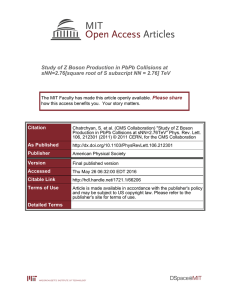
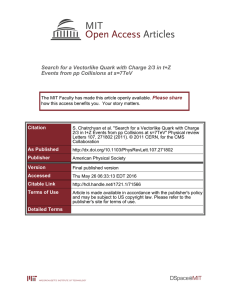
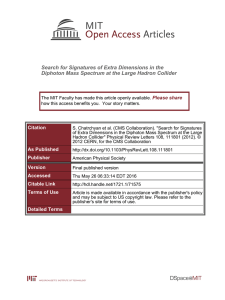
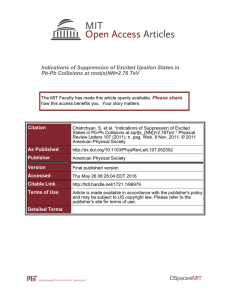
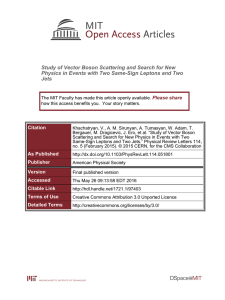
![Measurement of the B[subscript s][superscript 0]](http://s2.studylib.net/store/data/012106816_1-b04183fb8c200db654782451413e2b09-300x300.png)
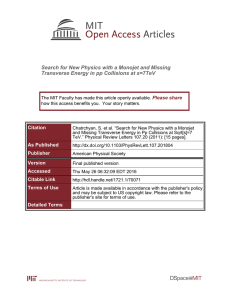
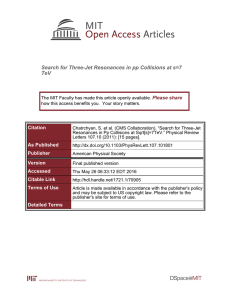
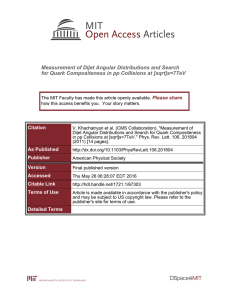
![Measurement of Prompt (2S) to J/ Yield Ratios in... and p-p Collisions at s[subscript NN] = 2.76 TeV](http://s2.studylib.net/store/data/012155530_1-f5b2e1a8e714bfa077d874554e68c6d7-300x300.png)
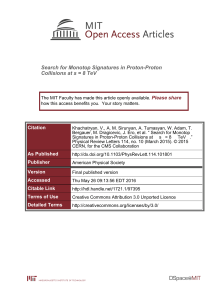
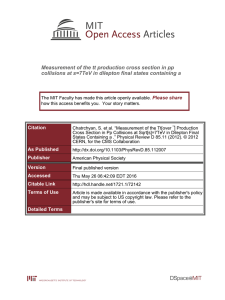
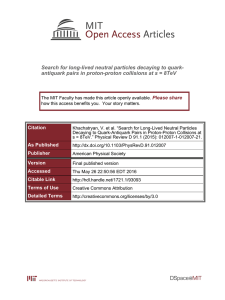
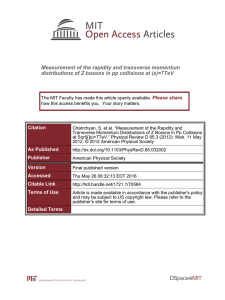
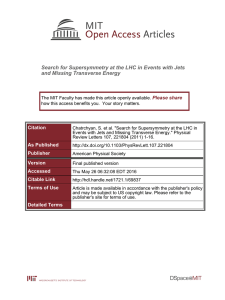
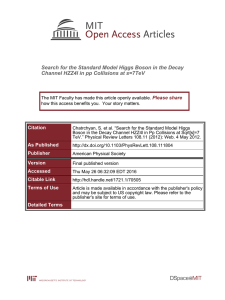
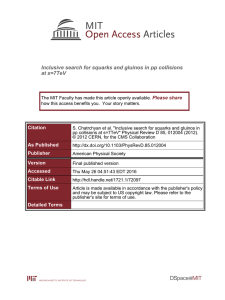
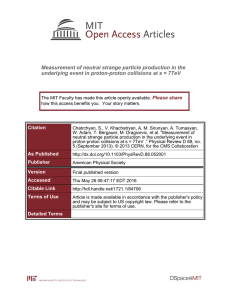
![Measurements of t[bar over t] Spin Correlations and Top-](http://s2.studylib.net/store/data/011743469_1-32d298db4410a621c0ce9c604782da65-300x300.png)
